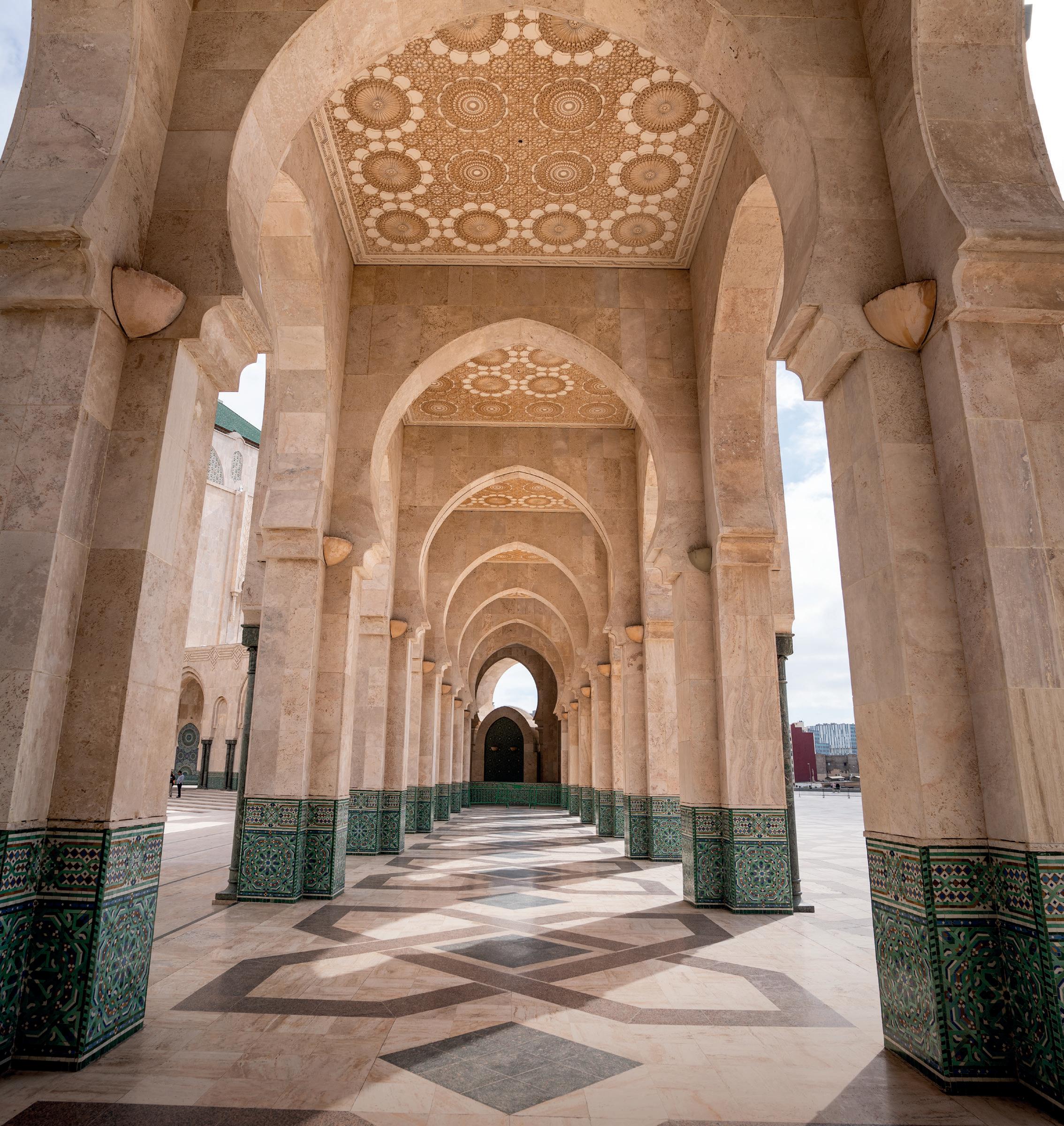









ARcHITEcTURAL EXPLORATIONS Pro tips for structural storytelling on the road. Cover image by
with the Tamron 17-28mm F/2.8 Di III RXD MAGAZINE I ssue 13 · Summer 2022 cHARTING THE NIGHT SKIES Up your astrophotography game with stargazing apps. NEW 17-70mm F/2.8 Di III-A Vc RXD Meet the world’s first fast-aperture standard zoom lens for APS-C mirrorless cameras, now for FUJIFILM X-Mount
Philip Ruopp
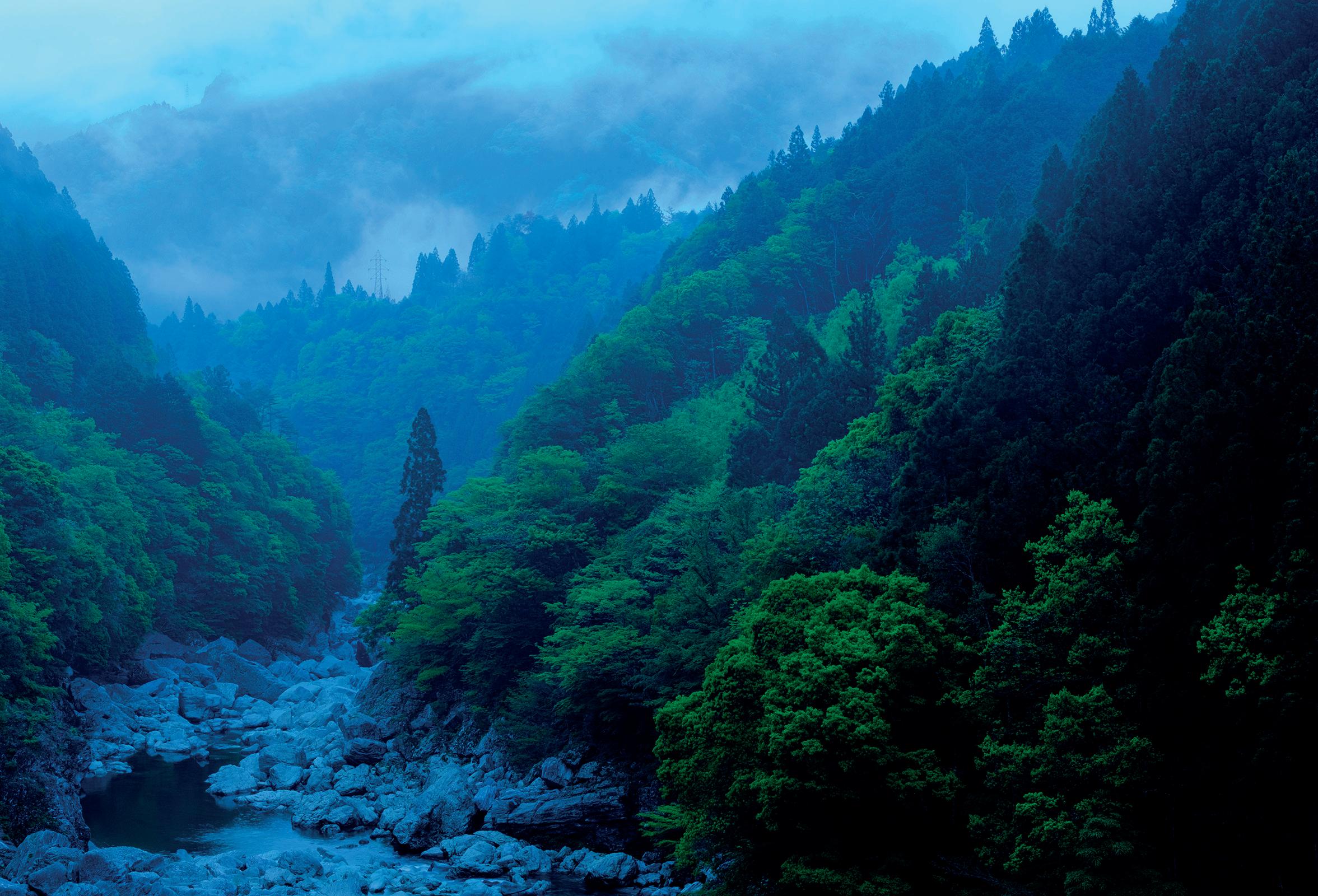










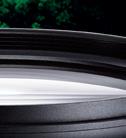


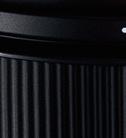


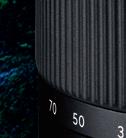





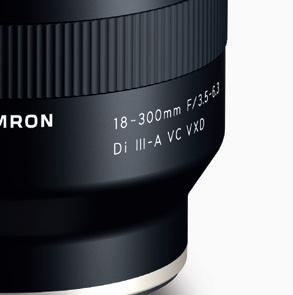




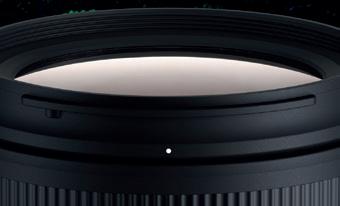

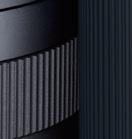
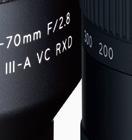
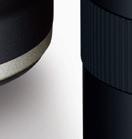








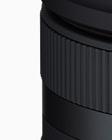


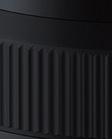









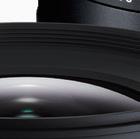


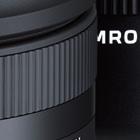



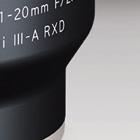
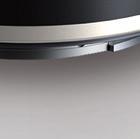






Wide to Ultra Tele Zooms for Crop-Sensor Shooters Fast, sharp, quiet, and small—these APS-C zooms are extraordinarily versatile and perfect for everyday photography. © Masaaki Aihara 17-70mm ONLY AVAILABLE AT YOUR AUTHORIZED TAMRON USA RETAILER www.tamron-usa.com APS-C MIRRORLESS APS-C MIRRORLESS APS-C MIRRORLESS WIDE-ANGLE ZOOM LENS for Sony E-Mount [ model B060 ] 11-20mm F/2.8 Di III-A RXD STANDARD ZOOM LENS for Sony E-Mount and FUJIFILM X-Mount [ model B070 ] 17-70mm F/2.8 Di III-A VC RXD ALL-IN-ONE ZOOM LENS for Sony E-Mount and FUJIFILM X-Mount [ model B061] 18-300mm F/3.5-6.3 Di III-A VC VXD
Dear Readers,
Happy summer! This issue has stories covering many topics including photographing America’s smallest towns. Put documentary photographer Rick Gerrity’s tips to use in your town. Or, if street photography is something you have wanted to try, take a look at Chrystofer Davis’ imagery to get ideas on how to approach this genre. Our special on photographing architecture during your travels is sure to get the creative juices going for your travel excursions or staycations. Travel with Bree Rose as she shares tips for photographing nature and culture around the world. Summer camping is the perfect time to try out some night sky photography, and Ken and Andre have a tutorial on using sky tracker apps to increase your chances of a great shot. Dive into deep water with Dustin Burkhouse as he photographs sharks. And Julia Cook provides insight into photographing wildlife that is sure to inspire. Remember, tag your shots on Instagram #withmytamron! See you again in the fall.
Sincerely, Stacie Errera Vice President, Marketing & Communications

TAMRON LENSES HONORED WITH THREE PRESTIGIOUS EISA 2022-2023 AWARDS


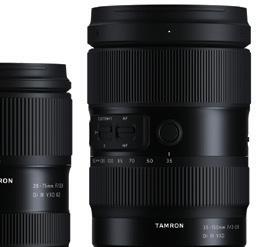

The Expert Imaging and Sound Association (EISA) presented its EISA Awards to three TAMRON lenses: 18-300mm F/3.5-6.3 Di III-A VC VXD (Model B061) for "EISA TRAVEL ZOOM LENS 2022-2023," 28-75mm F/2.8 Di III VXD G2 (Model A063) for "EISA STANDARD ZOOM LENS 2022-2023" and 35-150mm F/2-2.8 Di III VXD (Model A058) for "EISA ZOOM LENS 2022-2023". TAMRON has been honored with EISA Awards for 17 consecutive years. Plus, this year TAMRON wins three prestigious awards. See the news section on tamron-usa.com for the EISA jury’s citation for each lens.
cONTENTS
4 TOP FEATURES


The new 17-70mm F/2.8 Di III-A VC RXD
The new 50-400mm F/4.5-6.3 Di III VC VXD
EXcURSION Bree Rose finds the magic in every destination with her Tamron lenses
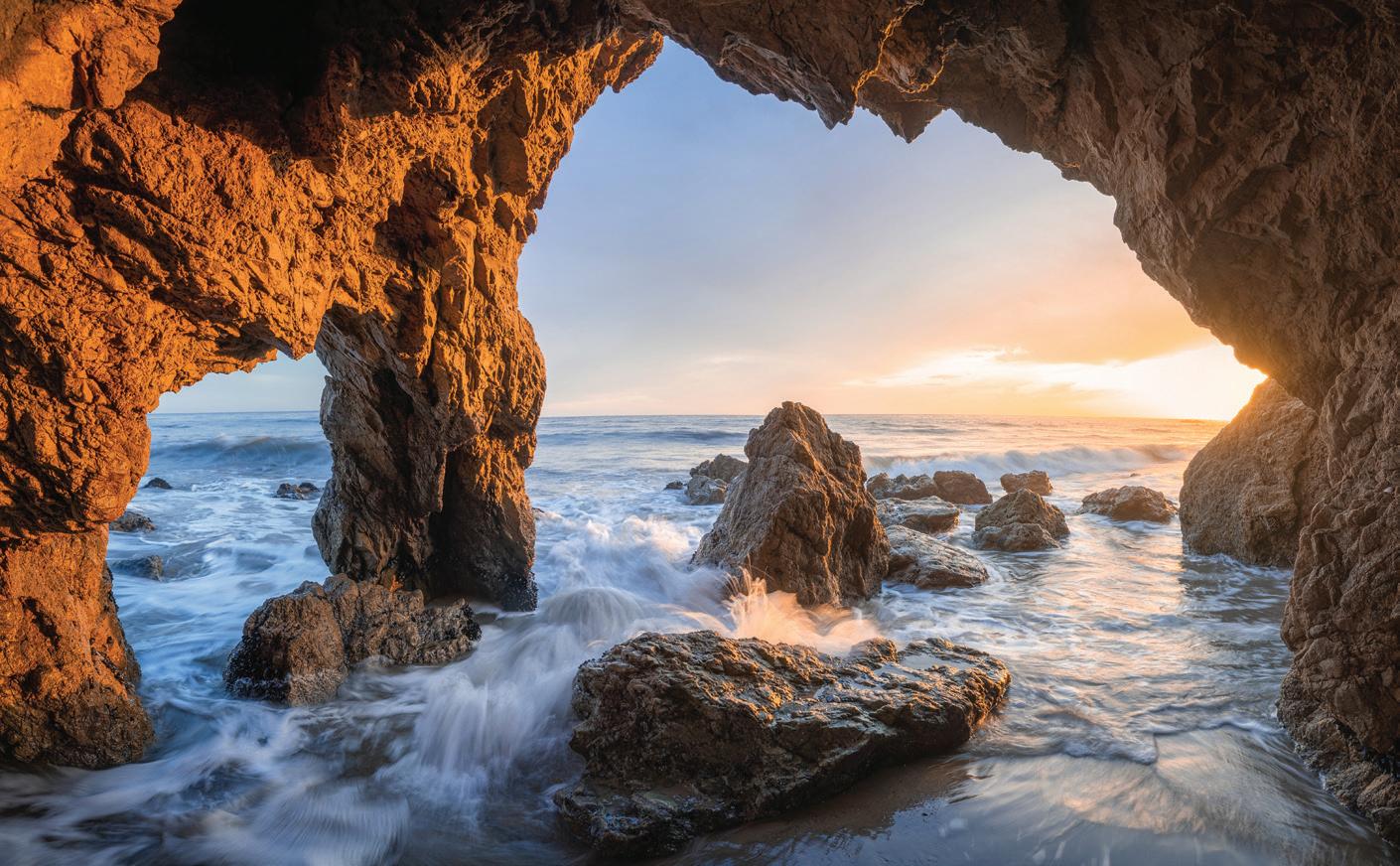
INTERVIEW
Chrystofer Davis creates street portraits in his hometown with the Tamron 18-300mm
INTERVIEW Rick Gerrity explores the Faces and Places of America
PRAcTIcE In Deep With the Great Whites and Dustin Burkhouse
PRAcTIcE
Made Accessible with Julia Cook
Tamron Magazine 3
6 UNDER DEVELOPMENT
8
12
16
24
TOP TIPS Up your astrophotography game with stargazing apps
SPEcIAL Pro tips for structural storytelling on the road
28
34
38
44
46
An
TAMRON NEWS Get news, interviews, photo tips and more twice a month. Visit Tamron at www.tamron-usa.com to sign up. FOLLOW US: FACEBOOK tamronlensesusa INSTAGRAM @tamronusa TWITTER @tamronusa PINTEREST @tamronlensesusa WATcH TAMRON IN AcTION www.youtube.com/user/tamronvids WELcOME
Wildlife
MY PROJEcT Framing the Scene with Chris Timothy
PARTING SHOT
Adirondack Sunrise with Joe Serio
© Chris Timothy
TOP FEATURES OF THE 17-70mm F/2.8 Di III-A VC RXD
FOR APS-C MIRRORLESS
World’s first fast-aperture standard zoom lens for APS-C mirrorless cameras with the focal length range of 17-70mm (4.1x zoom ratio) now available for FUJIFILM X-Mount
The Tamron 17-70mm F/2.8 Di III-A VC RXD (Model B070) is a fast everyday zoom lens for Sony E-mount and FUJIFILM X-Mount APS-C mirrorless cameras. Sharp, quiet, and small— this APS-C zoom lens is extraordinarily versatile and perfect for everyday photography. Designed specifically for use with APS-C mirrorless lens cameras, it is light weight and compact, even with VC image stabilization and a host of other user-friendly features. In your everyday life and on your trips to distant places, this lens captures all the excitement and discoveries with the finest possible detail.
Focal length of 17-70mm for shooting in a broad range of situations With a focal length range of 17mm to 70mm (a full-frame equivalent of 25.5105mm), this is the world’s first fastaperture F2.8 standard zoom lens for APS-C mirrorless cameras to achieve a 4.1x zoom ratio. It’s ideal for a variety of scenarios, from portraits and street snapshots, to landscapes and even close-ups.

Your key to beautiful, brilliant video shooting
Flourine Coating
Light & Compact 4.7" long, 18.5oz.
RXD autofocus (Rapid eXtrasilent Drive)
Camera-based lens unit firmware updates* Uniform Ø67 filter
Moisture resistant lens construction
MOD 7.5" (17mm) 15.4" (70mm)
The lens is ideal for not only still photography but also for video shooting since it provides minimal focus breathing, an undesirable phenomenon in which the angle of view changes * Varies by camera bodies
TOP FEATURES 4 Tamron Magazine
VC Image Stabilization
depending on the focusing distance during videography. In addition, the quiet RXD AF drive motor and the VC image stabilization mechanism facilitate hand-held video shooting.
TAMRON’s proprietary VC for stable photography and video shooting
The 17-70mm F2.8 utilizes TAMRON’s highly regarded VC image stabilization system to maximize the inherent optical performance of the lens. It reduces the degradation of picture quality caused by minute camera shake that is likely to occur during handheld shooting at slow shutter speeds under low-light conditions indoors or at dusk. When shooting video, image stabilization leveraging AI technology will automatically perform the best compensation for different shooting situations.
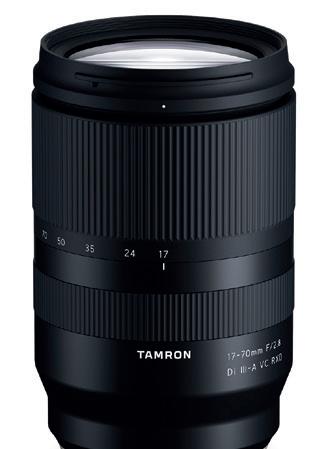
Compact, lightweight design is the perfect match for APS-C mirrorless cameras
This lens was created through the uncompromising pursuit of portability optimized for use with APS-C Sony E-mount and FUJIFILM X-mount cameras. Even with the inclusion of high-performance VC, the 17-70mm F2.8 is extremely light weight and compact, with an overall length of just 4.7” and weight of 18.5 oz. It is a very versatile lens for travel, where small bags are preferred, and is a great portable lens for daily use.
The AF drive on the 17-70mm F2.8 includes an RXD motor unit to help you stay focused on the action. RXD uses an actuator to precisely control the rotational angle of the motor, allowing it to directly drive the focusing lens without passing through a reduction gear. A sensor that precisely detects the position of the lens enables high-speed and accurate AF, which is ideal when shooting continually moving subjects or recording video. And with a focusing system that is both smooth and quiet, the 17-70mm F2.8 lets you shoot free from stress not worrying about the drive sound in a quiet environment.
NEW 17-70mm F/2.8 Di III-A Vc RXD

HIGHLIGHTS IN FOcUS:
17-70mm F/2.8 Di III-A VC RXD
67mm filter size
The shared 67mm filter size enables efficiency in filter use; the same polarizer filters, or other filters, and lens caps can be shared between all models.

Mounts Sony E-Mount, FUJIFILM X-Mount
Close-Up Shooting
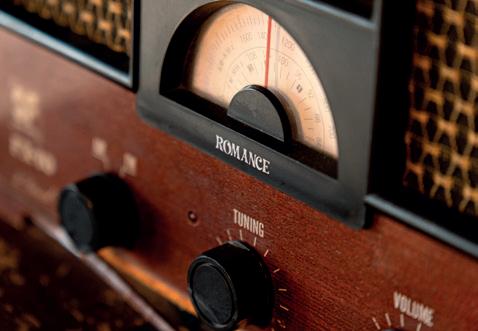
Create dramatic images with 7.5” MOD at the wide-angle end and 15.4” at the telephoto end
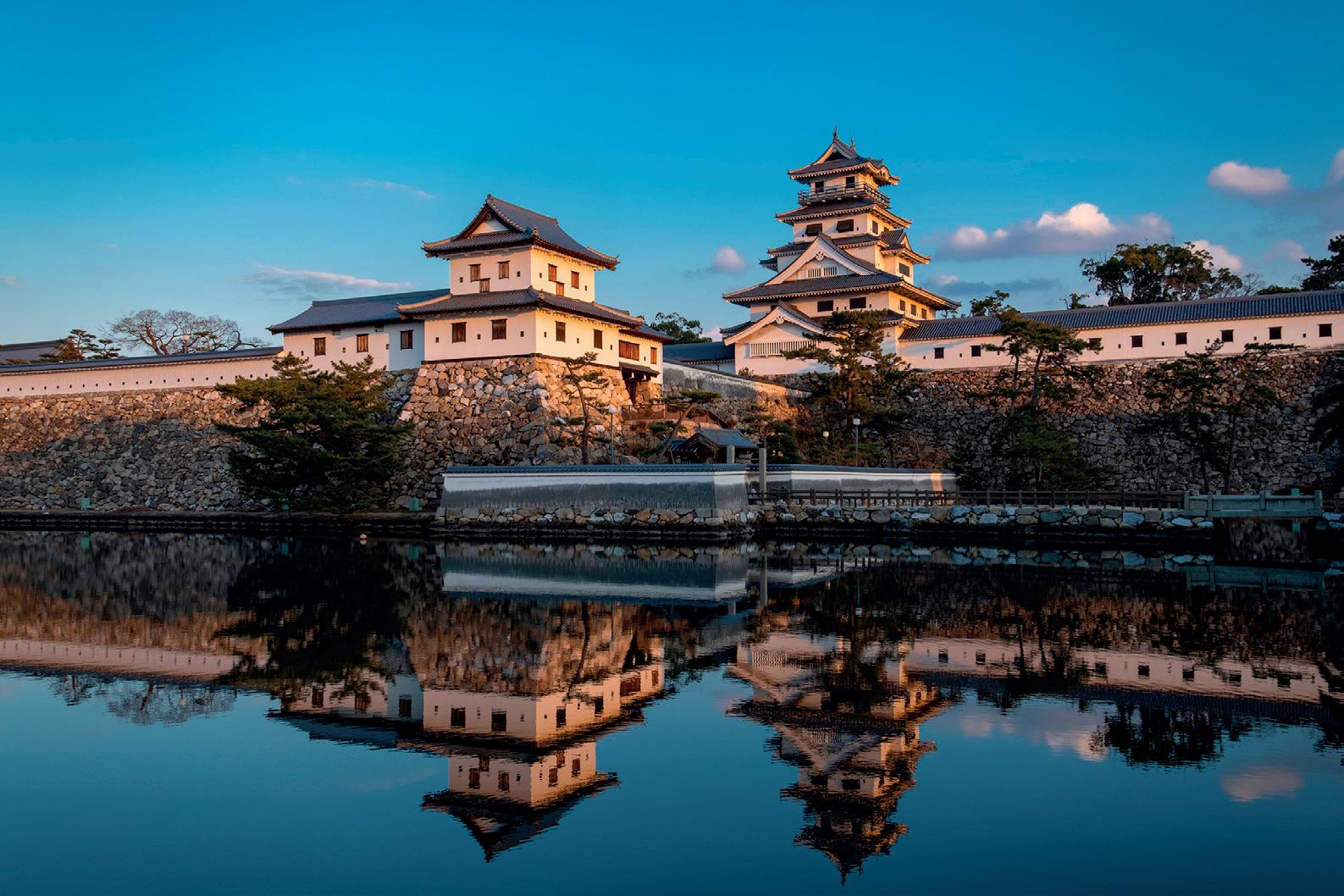

Superb Image Quality
With 16 elements in 12 groups, the lens utilizing an effective allocation of two GM (Glass Molded Aspherical) lens elements and one aspherical hybrid lens element to ensure high resolution and high contrast in the center, corners and edges of the image.
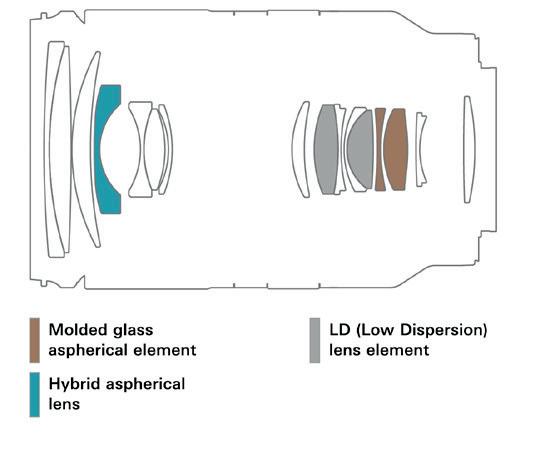
High performance autofocus system means you’ll own every shooting opportunity
TOP FEATURES
Moisture-Resistant Construction Seals at all critical points in the lens provides extra protection when shooting in inclement weather.
Model B070 Focal Length 17-70mm Max. Aperture F/2.8 Blades 9 (circular diaphragm) MOD 7.5 in (WIDE) 15.4 in (TELE) Max. Mag. Ratio 1:4.8 (WIDE) 1:5.2 (TELE) Length 4.7 in Weight 18.5 oz. Filter Size ø67mm Max. Diameter ø74.6mm
19.2mm 1/50 sec at f/8 ISO 160 with X-T4 (Film simulation: ASTIA)
Tamron Magazine 5
Daisuke Fujimura
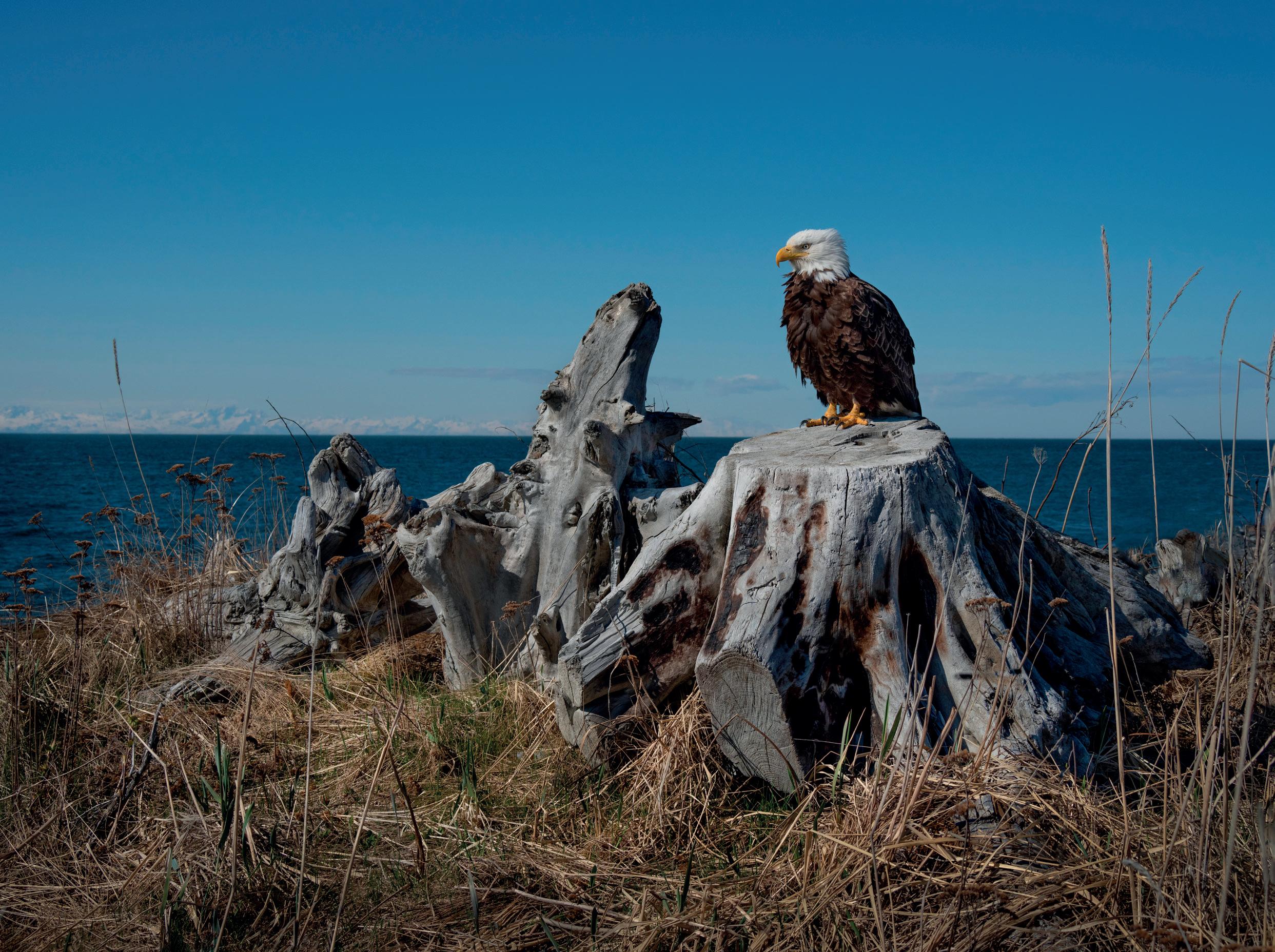
UNDER DEVELOPMENT UNDER DEVELOPMENT! 50-400mm F/4.5-6.3 Di III VC VXD FOR SONY FULL-FRAME MIRRORLESS CAMERAS Zoom from 50mm ‘standard’ focal length all the way out to 400mm ultra-telephoto 6 key points you should know about the new 50-400mm F4.5-6.3 Di III VC VXD (Model A067), an ultra-telephoto zoom with an unprecedented starting focal length of 50mm! 6 Tamron Magazine 50mm, F/9.0, 1/2000 sec., ISO 400 (4:3 aspect ratio) © Lisa Langell
POINT 1
THE IMPOSSIBLE DREAM OF A 50-400mm ULTRA-TELEPHOTO ZOOM LENS HAS ARRIVED – EXCLUSIVELY TAMRON, IT LETS YOU COVER SPORTS SCENES FROM A NEW ANGLE
Until now, the 70-200mm and 100400mm zooms have been the go-to lenses for shooting sporting events. But in those situations where you can’t change your position to get a wider view, or you need to get more in the picture, you must either switch lenses or simply give up. That was yesterday. Today, by starting at 50mm, this new 50-400mm shatters those limitations. It’s the ONLY ultra-telephoto zoom that is 50mm at the wide end among lenses for fullframe mirrorless cameras. This lets you shoot everything from wide shots to zoomed-in photos with a single lens, no lens-swapping needed. So now with one telephoto zoom, you can capture close-up action shots of a single athlete, a group of players on the field competing against one another, or the action as it moves closer to the sidelines.
POINT 2
OUTSTANDING IMAGE QUALITY THROUGHOUT THE ENTIRE ZOOM RANGE
From the 50mm starting point through the 400mm ultra-telephoto end, high image quality is delivered across the entire 50-400mm range through the precisely engineered arrangement of special lens elements.


POINT 3
HIGH SPEED, HIGH PRECISION LINEAR MOTOR FOCUS MECHANISM – VXD
The 50-400mm F4.5-6.3 utilizes the renowned VXD (Voice-coil eXtremetorque Drive) linear motor focus mechanism that combines class-leading speed with precision. The VXD, which is highly trusted for the latest ultratelephoto and telephoto zoom lenses — the 150-500mm F5-6.7 and 35-150mm F2-2.8 — provides smooth and accurate focusing not only for sports scenes but

for all types of shooting.
TAMRON’s proprietary VC image stabilization

TAMRON’s Vibration Compensation (VC) image stabilization mechanism effectively controls camera shake that typically becomes problematic when shooting at telephoto focal lengths. Even when handheld shooting under low-light conditions, such as dimly lit interiors or night landscapes, the degradation of picture quality is reduced.
POINT 4
ENHANCED OPERATION PLUS CUSTOMIZATION OPTIONS
Zoom from the widest angle out to 400mm with a short 75° rotation of the zoom ring to ensure that you never miss any of the action. And for true customization, the integrated Connector Port connects to a computer, thereby allowing you to use the dedicated TAMRON Lens Utility™ software to customize various functions and update the firmware when necessary. Beginning with this model, a new Focus Limiter control feature is available.
TAMRON concentrated on ease of operation so that you can enjoy comfortable shooting in both AF and MF modes.
POINT 5
LIGHTWEIGHT, COMPACT DESIGN WITH A FILTER SIZE OF 67mm

Despite covering up to 400mm, the 50-400mm F4.5-6.3 is incredibly compact with a length of just 7.2” and a light weight of 40.7 oz. It’s about the same weight and size as a conventional 100-400mm class zoom. The weight is 44.1 oz. when combined with the optional Arca Swiss- compatible tripod mount. Additionally, the 50-400mm F4.5-6.3 features the 67mm filter size that’s
common to many of the TAMRON lenses for mirrorless cameras, so you can share various filters like costly PL and ND filters instead of investing in separate filters for each lens.
POINT 6
HALF-MACRO PHOTOGRAPHY WITH A 1:2 MAGNIFICATION RATIO AT 50mm
You never expected this much versatility from an ultra-telephoto zoom lens! Move in close and enjoy half-macro shooting with a Minimum Object Distance of just 9.8” and a maximum magnification ratio of 1:2 at the 50mm zoom setting.
UNDER DEVELOPMENT
Tamron Magazine 7
Watch Tamron social media and sign up for Tamron eNews to learn more details about this new lens as they become available this Fall.
FINDING THE MAGIC

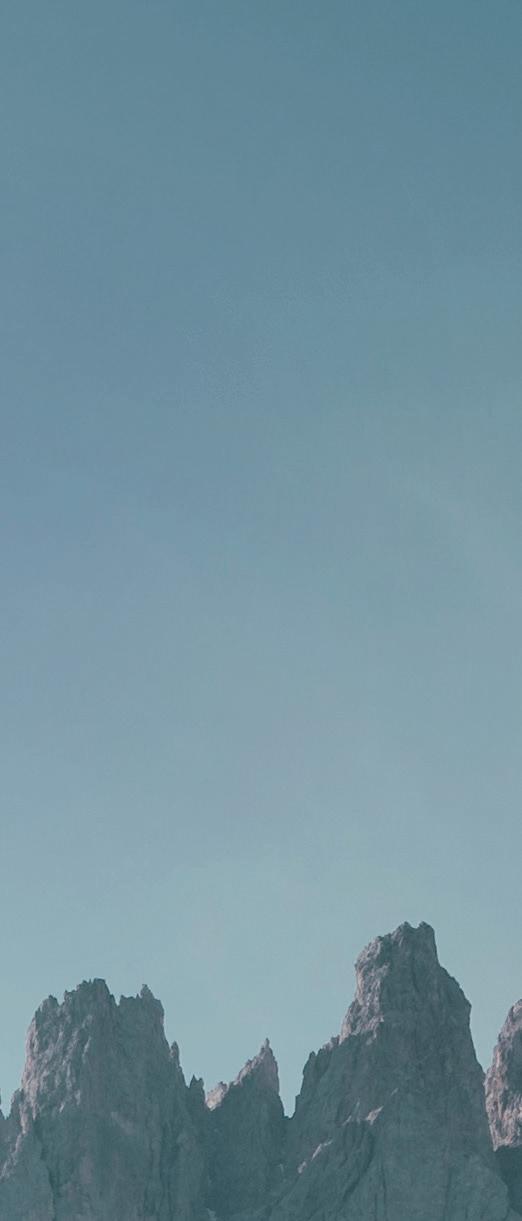

Bree Rose uses her Tamron 17-28mm F/2.8 wide-angle zoom and 28-200mm Di III RXD all-in-one lens to extract the beauty in every destination.

 PHOTO: BREE ROSE
PHOTO: BREE ROSE
EXcURSION 8 Tamron Magazine
28-200mm (40mm), F/5.6, 1/640 sec., ISO 125

17-28mm (20mm), F/3.5, 1/250 sec., ISO 100
When Bree Rose loads up her backpack and sets out on her travels, ready to explore whatever destinations find their way in front of her camera, she’s looking for something that’s almost unexplainable. “I wish I could say it’s my photographic style itself that’s magical,” she says. “But it’s usually the landscapes themselves that hold that magic—it’s simply my job to pinpoint that beauty and then draw it out. The scenes I encounter range from the beautiful to the bizarre. I’ll often stand in front of a landscape and not even be able to move, because they’re just so breathtaking.”
The US-based travel photographer, who got her start in 2018 when she bought a one-way ticket to South America, is now living her dream, globetrotting and documenting her journeys, all while trying to inspire others to do the same. She’s since built partnerships with National Geographic, Burt’s Bees, The North Face, Adobe Lightroom, and, of course, Tamron, among others. What’s helped draw notice to her work is her ability to transcend photography and instead offer the viewer an experience. “I want to transport the viewer to the exact spot I’m standing in when they see my photos,” she says.
Whether she’s in Europe, South America, or back home in the US, Bree has a Tamron lens power duo in her bag: the Tamron 17-28mm F/2.8 Di III RXD wide-angle lens and 28-200mm Di III RXD, the first all-inone zoom that starts at F/2.8, for her Sony

EXcURSION
Tamron Magazine 9
mirrorless camera system. “When I’m hiking and backpacking, the weight of what I’m lugging around can really add up,” she says. “These two lenses are all I need to capture the full breadth and depth of the destinations I’m visiting.

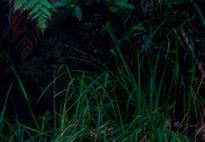
The 17-28 and 28-200 are super-lightweight and very sharp, and the variety of focallength ranges that are at my fingertips is phenomenal. I can go ultra-wide to capture the entire span of a rock formation, or I can zoom in to a mountain peak with the moon behind it to encapsulate just how big that moon is.”
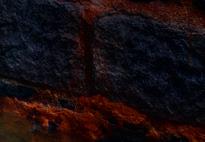
Until recently, the 28-200 has been Bree’s workhorse. “I don’t have a lot of time to be switching lenses out when I’m scooting from one place to another,” she says. “That compact 28-200 has proven invaluable when I’m pressed for time. During my solo trip through the Dolomites last July, for example, the Church of St. John was at the top of my bucket list. It’s a Baroque-style 18th-century chapel nestled in a green meadow in South Tyrol, Italy, and when I finally had the chance to photograph it, the Dolomites looming in the background, I had my 28-200 ready.
The moment the sun peeked over the mountain range, the light illuminated the church.”

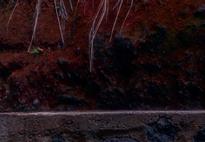
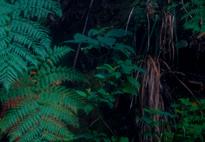
Lately, Bree has been experimenting more with the 17-28. “During my monthlong backpacking trip in Guatemala, Lake Atitlan was the highlight of my experience,” she says. “The lake is situated in a volcanic crater and is one of the country’s most visited locations. Sunrise conditions were amazing on the particular morning I was there, helping to create beautiful dynamic light for all of my images. I used the 17-28 here for a wide-angle portrait, allowing me to capture the background for context.”
Another one of Bree’s favorite locations in Guatemala was Las Fuentes Georginas, a hot spring located about 140 miles from Guatemala City. “After a long bus ride, it was the best place to relax at the end of an exhausting journey,” she says. “The hot spring is surrounded by enormous walls covered in greenery, and in order to capture as much of its vastness as possible, the 1728 was the way to go.”
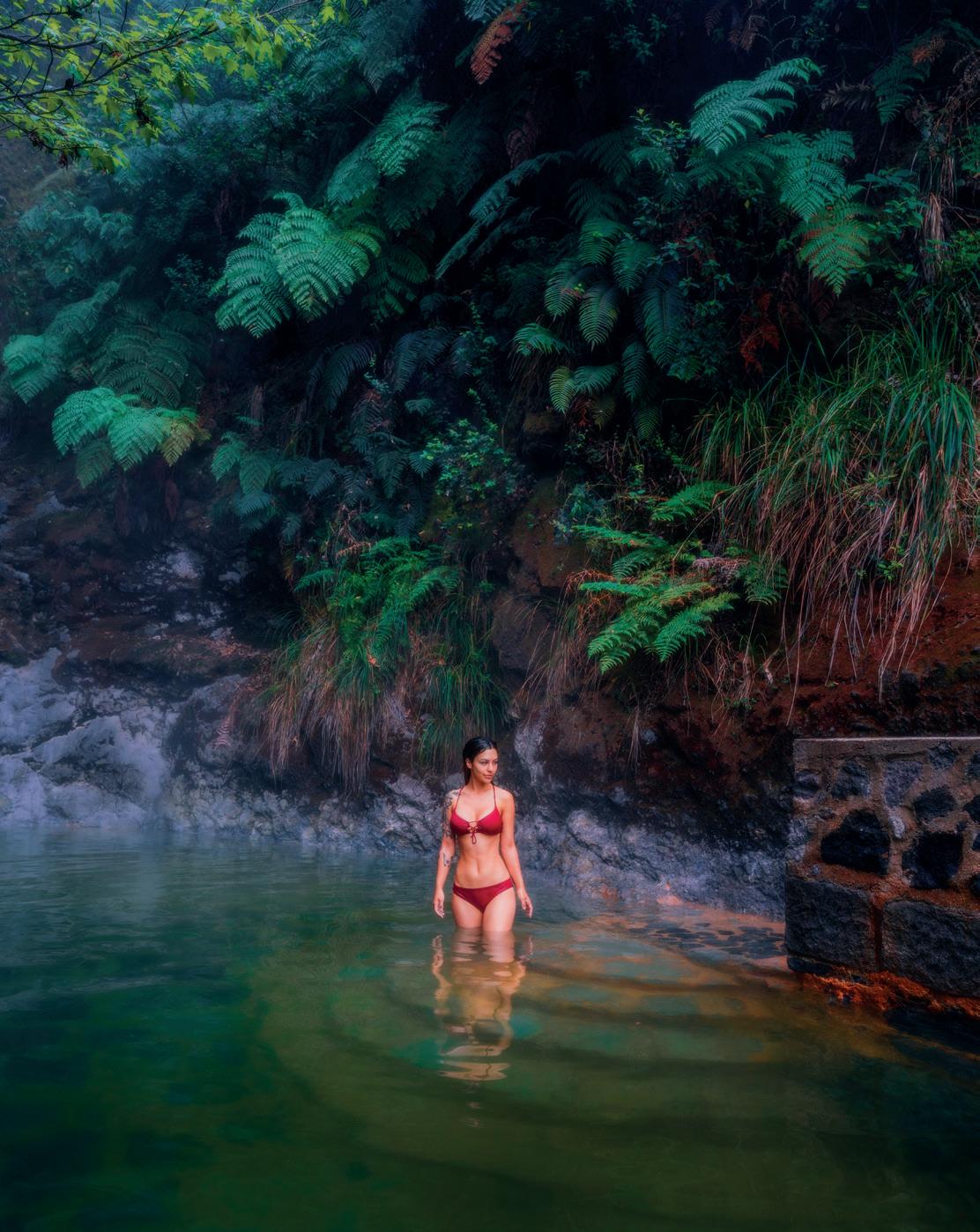
Even when she’s taking a breather back in the States, there’s no dearth of destinations at Bree’s disposal. “I especially love wandering around the American Southwest, which has some of the wildest landscapes imaginable,” she says, though she concedes that the treks there aren’t always the easiest.
“The Great Chamber at Cutler Point, part of the Grand StaircaseEscalante National Monument in Kanab, Utah, is a journey,” she says. “You have to have a 4x4 and know how to drive well on sand. There’s a short but steep hike to get to the cavern, which looks like a very shallow bowl. Putting a person in my photos (often myself) helps me offer a sense of scale for some of these locales.”
part of the Grand Staircaseto drive well on sand. There’s a short but steep hike to get to the cavern, shallow bowl. Putting a person in my photos offer a sense of scale for the Wave in Arizona, a


That’s also how she composed her photo at the Wave in Arizona, a sandstone formation located in the Coyote Buttes North area. “To win a lottery ticket to visit the Wave, you have to either
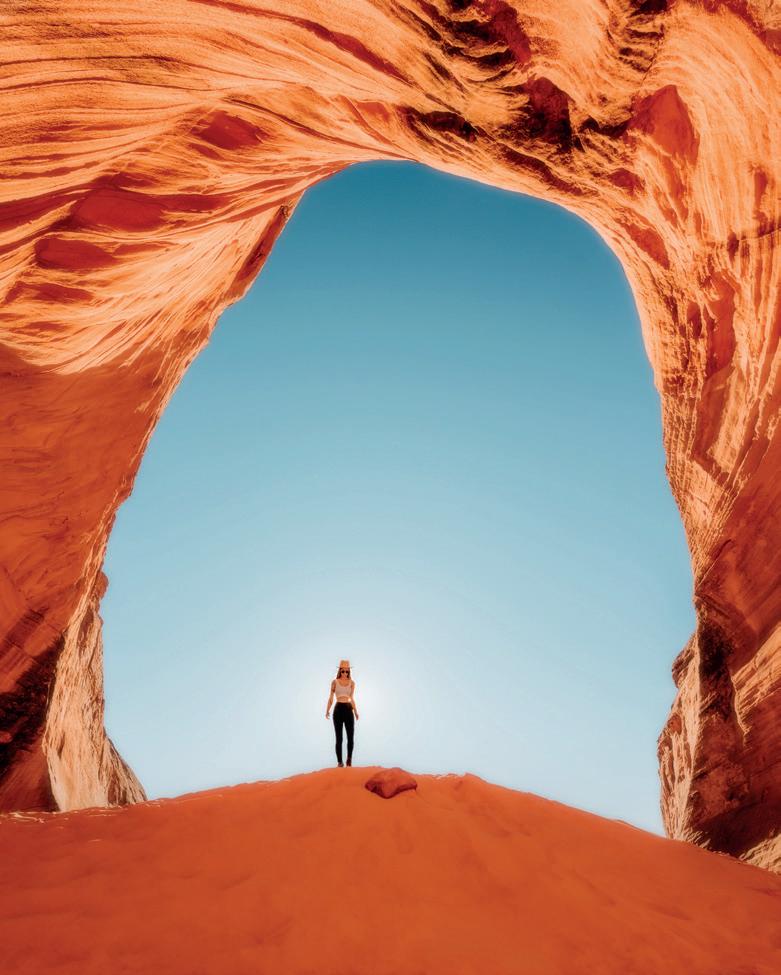

Buttes North area. “To win a lottery ticket to visit the Wave, you have to either













EXcURSION
10 Tamron Magazine
17-28mm (17mm), F/7.1, 1/80 sec., ISO 125 17-28mm (22mm), F/4.5, 1/125 sec., ISO 320
17-28mm
F/8, 1/400
(18mm),
sec., ISO 200
live in Kanab or be hanging around for a few days,” Bree says. “Even then, there’s no guarantee you’ll nab a ticket. We overheard one gentleman say he’d been trying to get his hands on a permit for 10 years! I was lucky enough to acquire one, and after hiking out onto that spectacular landscape, I used the 17mm end of the 17-28 to capture more foreground. That allowed me to not only showcase more of the landscape, but also to drive a leading line right up to the person in the photo.”
Deep within Arizona’s Coconino National Forest, on what’s known as the End of the World Trail, lies Jenga Rock, a teetering structure that looks a lot like the game it’s named after. “This rock is as sketchy as it is gorgeous,” Bree says. “My goal for this image was to isolate the tower while also highlighting the expanse of the land around it. This time, my friend Spencer was the model. After he climbed to the top of the rock, I used the wide end of the 28-200 to showcase that heart-stopping drop-off, with the rest of the landscape stretching into the distance. It really does feel like the end of the world there.” 28-200mm (28mm), F/2.8, 1/800 sec., ISO 160 17-28mm (17mm), F/8, 1/50 sec., ISO 200 28-200mm F/2.8-5.6 Di III RXD [model A071] 17-28mm F/2.8 Di III RXD [model A046]

Bree Rose, creator of Eye of She, is a travel photographer and entrepreneur based in the US. Her journey began in 2018 with a one-way ticket to South America and she's been exploring every corner of the world ever since. Her unique aesthetic has helped her establish an incredible audience, which has led to partnerships with tourism boards and top brands such as The North Face, Adobe Lightroom, and National Geographic. Eye of She is the brand for dreamers and adventurers and focuses on inspiring people to live life to the fullest and turn their dreams into their reality.
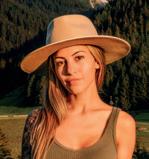

Instagram @eyeofshe





EXcURSION
PHOTO: BREE ROSE
ABOUT: BREE ROSE
Tamron Magazine 11
“THE 17-28 AND 28-200 ARE SUPER-LIGHTWEIGHT AND VERY SHARP, AND THE VARIETY OF FOCAL-LENGTH RANGES THAT ARE AT MY FINGERTIPS IS PHENOMENAL.”
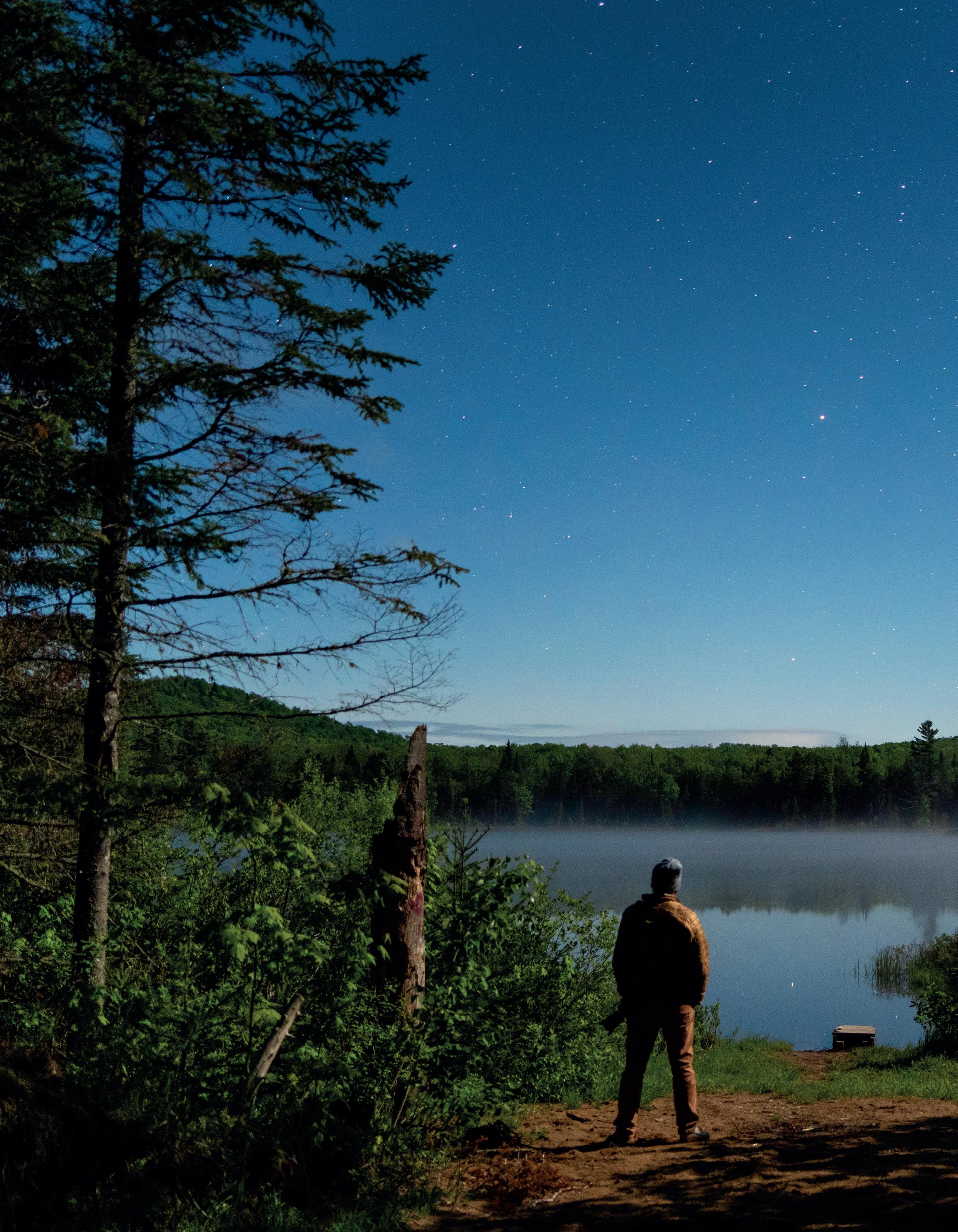







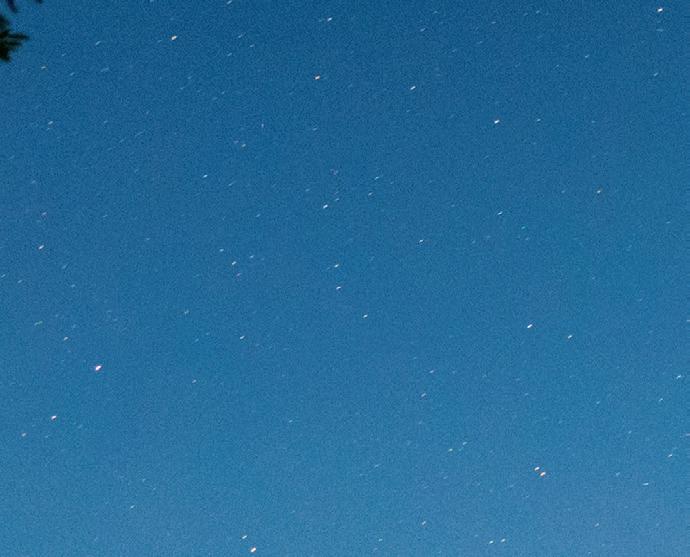
TOP TIPS
CHARTING THE NIGHT SKIES Up your astrophotography game with stargazing apps. 28-200mm (28mm), F/2.8, 13 sec., ISO 3200
PHOTO: KEN HUBBARD
If you’re finally ready to try your hand at night-sky photography and capture that image of the Milky Way you’ve always wanted, you’ll need to do more than show up in a dark field and point your camera at the cosmos. Knowing exactly where the stars, constellations, and planets will be, as well as any other heavenly bodies that might make a specialguest appearance, will help you position them against your chosen landscape and nail the perfect shot. Stargazing apps on your phone or other mobile device can prove invaluable in this effort.

After checking local weather and lightpollution maps, tapping into stargazing apps can streamline your astrophotography adventures by first guiding you toward the best locations to shoot in, then how to decipher the skyscape of twinkling celestial objects once you get there. “These apps help you determine where the stars and planets

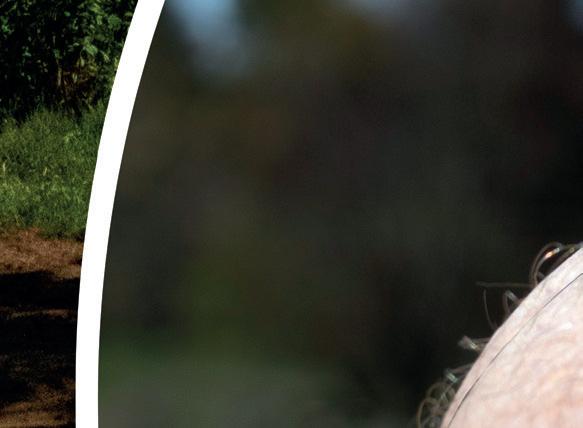



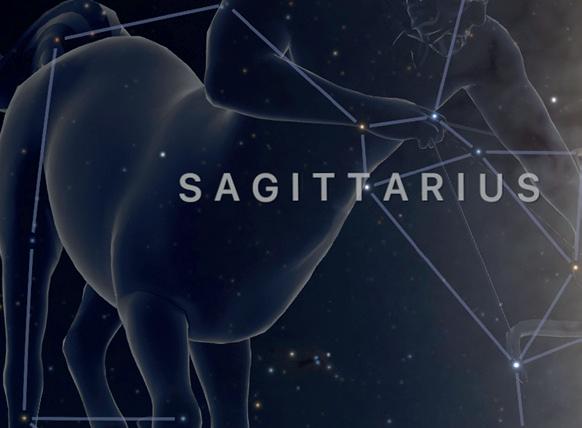





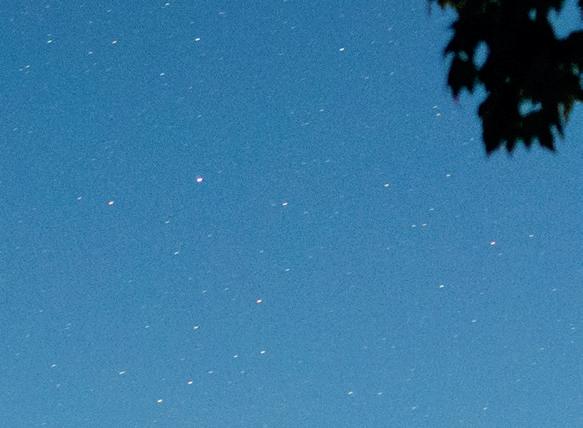






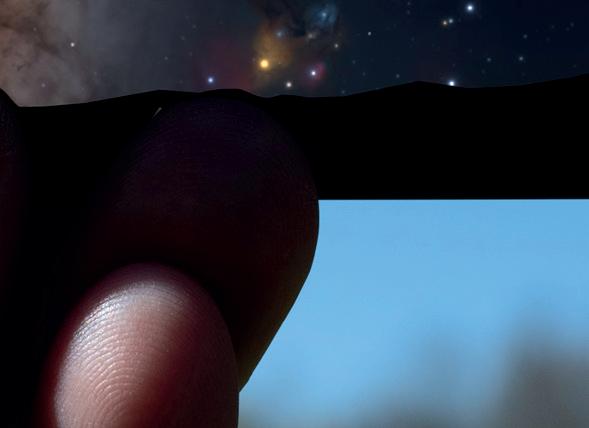

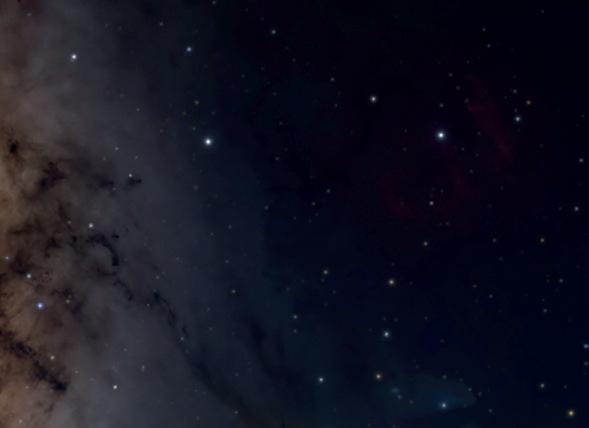
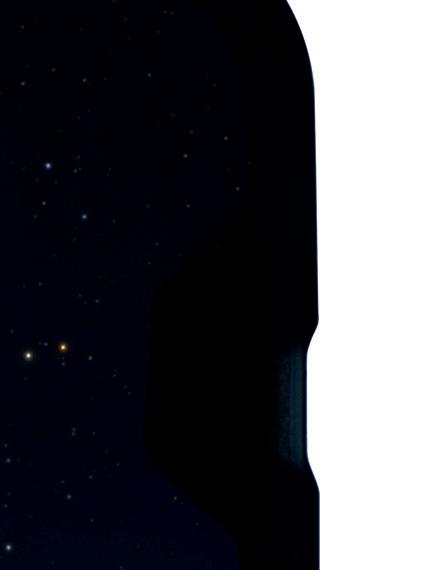




Magazine TOP TIPS
Tamron
will be in relationship to where you’re standing, as a sort of previsualization of what you’re going to shoot,” says Tamron tech consultant André Costantini. “Then, once you get to your location, you can identify everything you’re seeing simply by pointing your phone at the sky.”
The key to a stunning astrophotography image is combining a sky scene with an eye-catching foreground, and the best stargazing apps can assist in that regard. This is especially handy if you’re only going to be visiting a particular location for a short amount of time. “You don’t want to spot a gorgeous location in Zion National Park, say, in the middle of the day and plan on shooting the Milky Way over that spot, only to find out when you get there that evening that it’s not set to pop up in the sky for another month,” André says. “Having a sky tracker app at your fingertips ensures you’ll be in the right place at the right time, so you can streamline your efforts and maximize your time.”
What kind of mobile sky app you ultimately pick depends on how much you’re willing to spend (many offer free versions, while pro versions can cost from a couple of bucks to a few ten-
spots) and what features you’re looking for. Basics will typically include timings for when and where particular stars, constellations, planets, and the Milky Way will appear in the night sky, as well as when golden hour and blue hour will

17-28mm (26mm), F/2.8, 13 sec, ISO 4000
arrive, the positioning and timing of sunrise and sunset, and the phases of the moon. “Knowing those moon phases is important, because if it’s too bright, it could eliminate a foreground you were considering or pollute the darkness—
17-28mm (17mm), F/2.8, 20 sec, ISO 3200
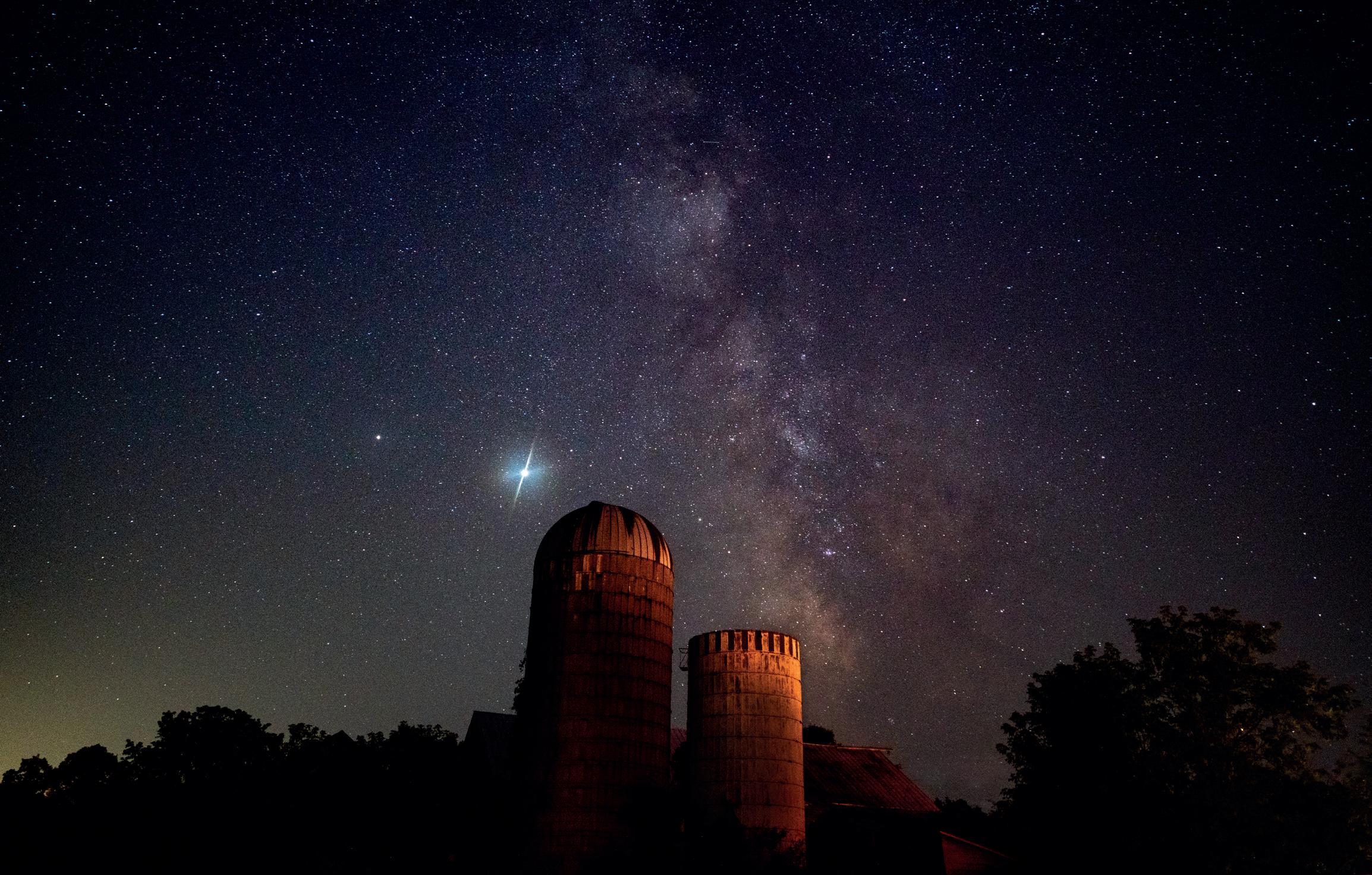
14 Tamron Magazine TOP TIPS
and therefore the clarity—of the sky,” André says.
More advanced features on stargazing apps include tools to help you take pictures of meteor showers and star trails; calendars of future astronomical events such as eclipses and comets; pronunciation guides; and augmented-reality overlays, which will drag such information as, say, various constellations onto what you’re viewing on your phone in real time, depending on the date and time you input. “Some apps might even allow you to zoom in on a particular star to offer a quick tutorial on what it is and its history, including how other cultures in the past may have seen it,” André says. “The lessons go as deep as the manufacturer want them to go.”
Just realize that, no matter which app you use, once you hammer out where you’re going and the time you need to get there, head to the location early.
“You’re not the only one using these apps,” André says. “You don’t want to arrive at your destination to find 50 people have already shown up before you and grabbed the prime shooting spots, especially in some of the more popular national parks.”
17-28mm (17mm), F/2.8, 20 sec, ISO 3200
RECOMMENDED STARGAZER PHOTO APPS


These apps consistently pop up on “best of” lists for photographers (all are available for both iOS and Android, unless otherwise indicated):
n PhotoPills: www.photopills.com
n Stellarium Mobile: https://stellarium-web.org
n SkySafari: https://skysafariastronomy.com
n SkyView: www.terminaleleven.com/ skyview/iphone
n Star Walk 2: https://starwalk.space/en
n Sky Guide (iOS only): https://apps.apple.com/us/app/skyguide/id576588894
n The Photographer’s Ephemeris (iOS only): https://photoephemeris.com
n Star Tracker: https://sites.google.com/site/ pyopyostudioapp
17-28mm (17mm), F/2.8, 20 sec, ISO 3200
Tamron Magazine 15 TOP TIPS
ARCHITECTURAL EXPLORATIONS



PRO TIPS FOR STRUcTURAL STORYTELLING ON THE ROAD.


One of the most exciting parts of traveling is exploring and photographing a city’s architectural treasures. Whether it’s the details found within an iconic sculpture, the leading lines of a stately skyscraper, or the curvature of a wrought-iron stairway winding down from a weathered veranda that catches your eye, Tamron has the glass you need to capture a city’s structural exteriors in the most aesthetically pleasing light. From a wideangle lens like the 17-28mm F/2.8 Di III RXD, to a prime lens like the SP 35mm F/1.4 for detail shots, to all-in-one zooms like the 18-400mm VC for focal-length flexibility during your wanderings, Tamron has you covered. Here, our experts share tips on how they use their Tamron lenses on the road to showcase a destination’s human-made masterpieces.

SPEcIAL
© Armando Flores

SPEcIAL SP 45mm · 1/400sec · F/6.3 · ISO 100
1Seek




















out unique angles for iconic buildings.







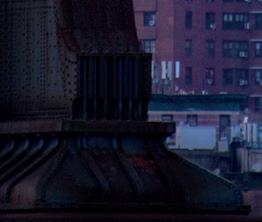


In every city, there are certain landmarks familiar to everyone. A constant challenge for photographers is to unearth new perspectives and angles that other photographers haven’t fully explored. To do so, it may be necessary to completely rethink the way you’re “seeing” a building. The search for creative angles may seem tedious at first, but only by doing so can you reinterpret a subject that’s already been photographed thousands of times. You won’t be disappointed with the results if you take the time to do so.
2Look up…

When traveling, you can get so caught up in the whirlwind of color and “newness” of the place you’re visiting that you can forget to turn your gaze skyward—up is great! The change in perspective from what our eyes usually see gives us the chance to capture images that are totally different from what we’re usually shooting at ground level. Cultivate the habit of looking up in every location you visit, then try to find at least one image that stands out from that perspective. Sometimes that image will be best captured with a larger focal length, sometimes with a really wide one. It’s always a fun challenge to work out which lens will tell the story best.
3…and look down.






We tend to look straight ahead when we’re walking, keeping our eyes focused on whatever’s right in front of us. Pause for a moment and peer over the edge of a veranda, rooftop railing, or stairwell. You might be surprised at the patterns, colors, and textures that are visible from this bird’s-eye view. Use traditional compositional guidelines, like the rule of thirds or the golden ratio, to draw the viewer’s eye to the most interesting part of the photo.

SPEcIAL 18
“PLAYFUL REPETITION … CREATES AN ALIVENESS TO THE IMAGE AS THE EYE MOVES UP, DOWN, AND AROUND THE SCENE OF EVERYDAY LIFE.”
© Glynn Lavender
© Billion Lim
© Philip Ruopp
4Scout for splashes of color.

If you wake up and are disheartened to find a dreary day outside your window, don’t fret. Allow your eye to scan the cityscape or landscape for a colorful row of boats, a vibrant barn door, or a brilliant patch of flowers adorning a building’s landscaping to add some cheer.

5But don’t shy away from less-colorful scenes.




If all of your architectural images are vibrantly colored, they’ll start to look the same. Instead, look for scenes that are either just one main color or, thanks to their lack of color, appear monochromatic. Cities on an overcast day are terrific for this type of imagery. The solid gray cement and glass of city buildings and a bland or brooding, stormy sky offer so many opportunities to shoot that it can transform a dull day of photography into a day of exciting shooting possibilities.

6Photograph city streets in the early morning or afternoon golden hour. The quality of the light and shadows at these times of day can add even more depth to the already interesting shapes, forms, and colors of the homes and buildings you encounter in your photographic adventures.
7Use the details as your subject.
Doors make for classic travel images that can tell a story and create a sense of place. Elements such as unique colors, texture, and ornamental accents can give the viewer a hint as to what part of the world you may be in. Instead of photographing an entire door, for instance, you can create a detail shot breaking the compositional rule of thirds with a line down the middle, while still nodding to the rule with the detail “subjects” in the cross sections.

Counter clockwise from top left:


18-400mm (220mm), 1/40th sec., F/6, ISO 250

11-20mm (11mm), 1/2500th sec., F/9, ISO 100
28-200mm (28mm), 1.6 sec., F/8, ISO 100
SP 45mm (45mm), 1/160th sec., F/8, ISO 200
SP 45mm (45mm), 1/60th sec., F/5, ISO 400
SP 35mm (35mm), 1/1600th sec., F/2.8, ISO 100
17-70mm (17mm), 1/10th sec., F/8, ISO 100
Tamron Magazine 19
SPEcIAL
© Thomas Adorff
© Kenna Klosterman
© Glynn Lavender
© Kenna Klosterman
8



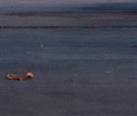





Add a human element.





Some cities have buildings that have been photographed thousands, if not millions of times. The Seattle Central Library, for instance, is a one-of-a-kind piece of postmodern architecture with angles, symmetry, reflections, and geometric shapes galore. While this building has no “bad angle,” one way to make an image like this unique is by adding a human element. Framing a subject walking through an exterior structure can create a more interesting story about the interplay between people and buildings.

9 Use asymmetrical repetition in creative ways.



You might spot a row of homes that have similar exterior elements—stairs, balconies, decorative bars, bright paint. But those elements may not be symmetrical or identical. This playful repetition, combined with people if you can get them in the frame, creates an aliveness to the image as the eye moves up, down, and around the scene of everyday life.
10 Incorporate motion.
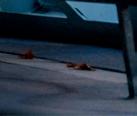

Architectural images, while often stunning, can also sometimes be static. Use a slower shutter speed to create motion blur as a local bikes or skateboards past a building or structure. Adding this kind of activity allows you to showcase the building with a more dynamic image, as well as offers a taste of the city’s daily hustle and bustle.

20 Tamron Magazine
SPEcIAL “USE A SLOWER SHUTTER SPEED TO CREATE MOTION BLUR AS SOMEONE BIKES OR SKATEBOARDS PAST A BUILDING OR STRUCTURE YOU’RE PHOTOGRAPHING.”
© Klaus Wohlmann
© Kenna Klosterman
© Kenna Klosterman
11Zoom in on building patterns, shapes, and textures.




Sometimes at first glance, a structure may not seem to hold that much visual appeal. By using a longer focal length and zooming in, you can draw attention to a structure’s “bones.” By shooting in black and white and playing with light and shadow, you can further accentuate the contrasts and geometrical elements that make up a building.
12 Employ leading lines

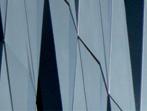








A building’s columns, wall seams, benches, windows, and doorways all provide a linearity that will enable you to compose and anchor your image. Perpendicular and parallel lines can add both unity and diversity within the same photo. Take advantage of these architectural elements to help you bring the viewer’s eye to a natural endpoint.
13
Tap into reflections.
Mirror images can enhance an already fantastic scene, whether you use a body of water, the slick surface of a street puddle after a downpour, or the glass walls of a building. Some reflective surfaces, like the shiny exterior of Chicago’s Cloud Gate structure (affectionately known to locals as the “Bean”), can offer you the ability to add creative distortion and a complementary view of the cityscape.

14
Photograph the city at night.

You’d be surprised at how different a city’s structures can look once the sun goes down. Where the light falls can bring focus to parts of the city otherwise ignored, or make a building that looks rather ordinary during the day a spectacular sight at night.
Counter clockwise from top left:
28-75mm G2 (28mm), 1/320th sec., F/2.8, ISO 200
SP 24-70mm G2 (70mm), 1/400 sec., F/8, ISO 400 18-300mm (18mm), 1/40th sec., F/22, ISO 1250 11-20mm (11mm), 10.0 sec., F/8, ISO 100
SP 45mm (45mm), 1/500 sec., F/8, ISO 100 18-300 (18mm), 1/250th sec, F/ 5.6, ISO 640 70-300 (300mm), 1/6400th sec., F/ 6.3, ISO 160
Tamron Magazine 21 SPEcIAL
© Yuich Maruya
© Itsuka Yakumo © Armando Flores
© Klaus Wohlmann

HIGHLIGHT 22 Tamron Magazine 17-70mm (70mm), F/2.8, 1/800 sec., ISO 200
Expand Your Photo Experience With An Advanced Standard Zoom Lens


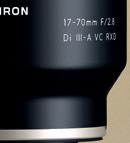







This advanced lens focuses extremely close for a standard zoom lens for APS-C mirrorless cameras. The MOD is just 7.5" at the wide-angle end and 15.4" at the tele end. When shooting very close to the subject, the lens enables expressive imagery with beautiful bokeh, a feature unique to fastaperture lenses.


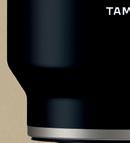
















HIGHLIGHT
17-70mm F/2.8 Di III-A VC RXD
THE NEIGHBORS OF NEWARK

Chrystofer Davis creates authentic street portraits in his hometown with the Tamron 18-300mm VC all-in-one zoom.

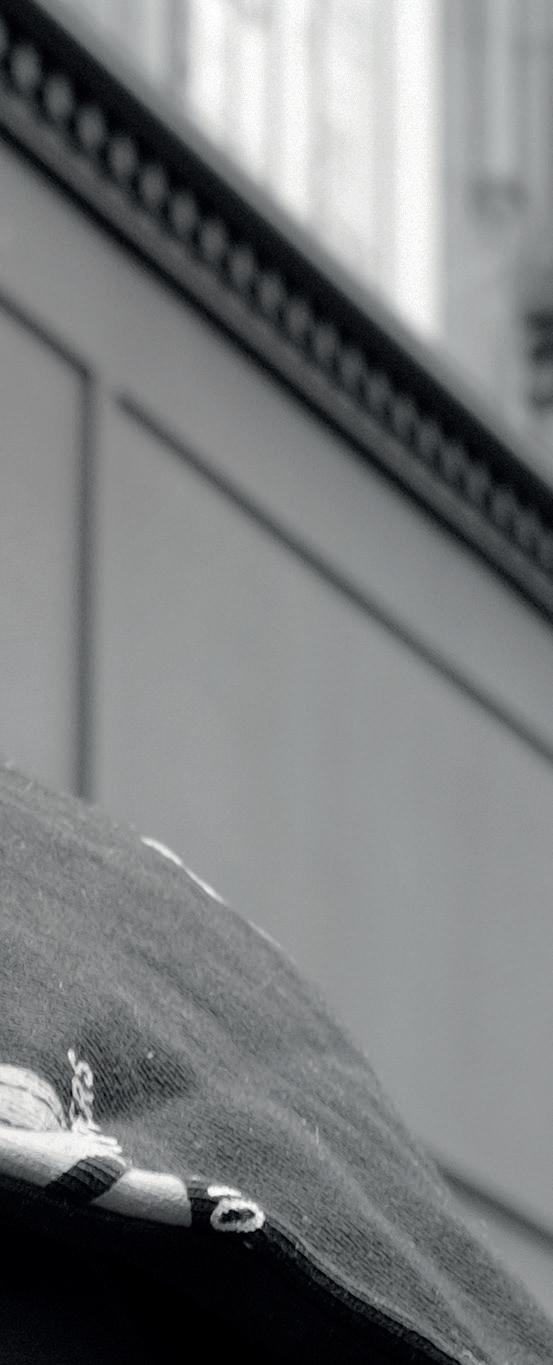


 PHOTO: CHRYSTOFER DAVIS
PHOTO: CHRYSTOFER DAVIS
INTERVIEW 24 Tamron Magazine
27mm, F/6.3, 1/38 sec., ISO 500
27mm, F/4.5, 1/120 sec., ISO 500
When Chrystofer Davis is roaming the streets of Newark, New Jersey’s largest city, scouting for subjects to take center stage in his documentary-style street portraits, he’s always on the lookout for intimate moments of engagement. “When I’m taking these type of pictures, what I’m doing isn’t about me—it’s about the people I’m photographing,” says the fine-art photographer, teaching artist, and filmmaker. “They’re pieces of a puzzle that tell an authentic story about my hometown.”

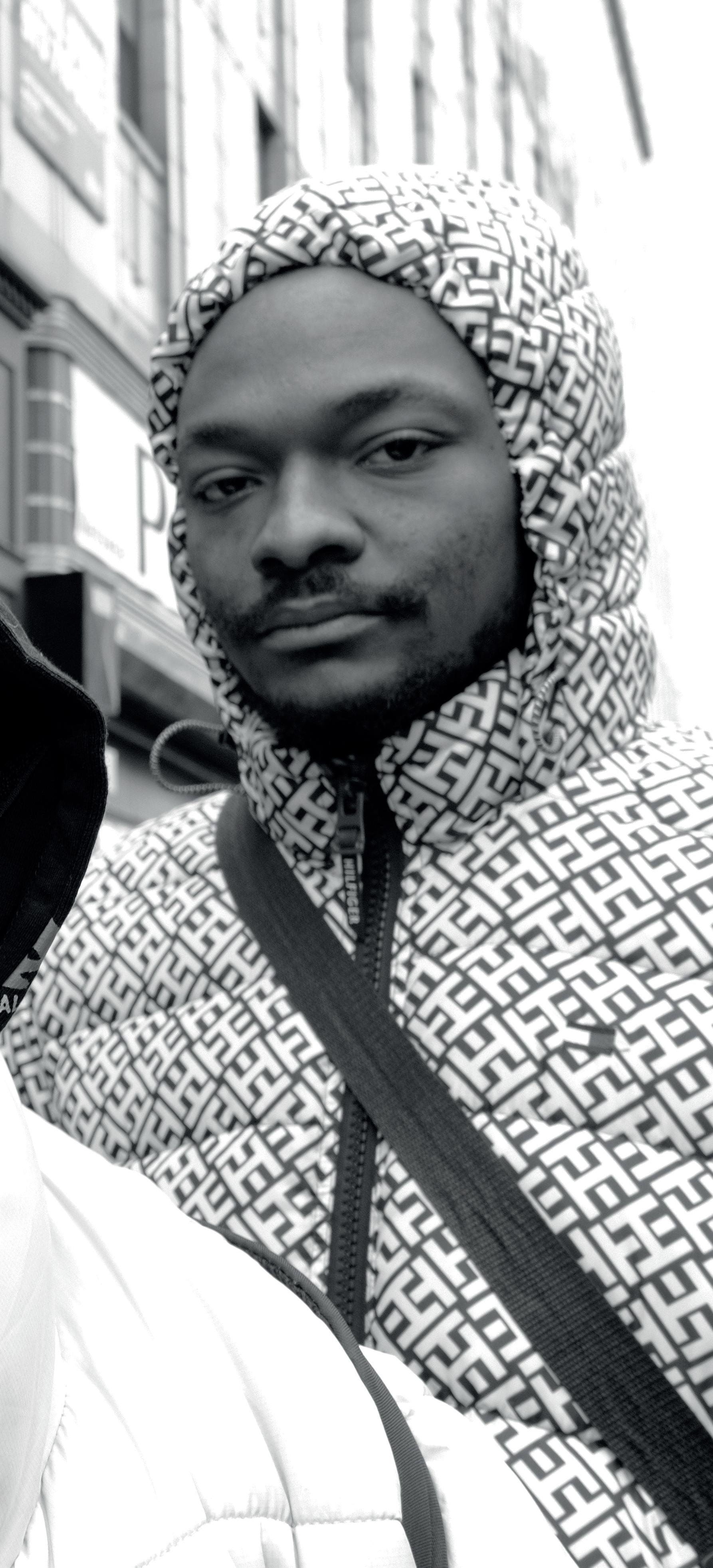
It’s that insider perspective Chrystofer wants to bring to his creations. “Sometimes, if a community is portrayed by someone from the outside, it can end up being a one-dimensional and somewhat inaccurate depiction,” he says. “I want to use my artistic skills to control the narrative of what Newark really looks like, especially the people who live there. I’ve lived here my whole life, and so much has changed. By documenting everyday moments in time, people 40 or 50 years down the road will have a better sense of what the city and residents were like in this particular period.”
The Tamron 18-300mm VC VXD all-inone zoom lens is integral to Chrystofer’s street photo workflow. “If I used a prime lens for this kind of work, I’d be stuck with one focal length and might miss those split-
INTERVIEW
Tamron Magazine 25
second moments,” he says. “A behavior or emotion can vanish in an instant. With the 18-300, I can stand in one spot and capture people walking by on the street 10 feet away, without intruding or interrupting their flow, then zoom in on a facial expression or the details of a building. Because I’m usually shooting handheld, the Vibration Compensation (VC) feature on this lens eliminates camera shake, so my photos stay sharp.”
Chrystofer’s process is less one in which he asks to take a portrait and more a collaboration between artist and subject. “I like to get to know the people I’m photographing before I jump into the picture-taking part of things,” he says. “I’ve had the chance to assist on a few shoots with Jamel Shabazz, who
60mm, F/4, 1/13 sec., ISO 1000

photographed life in New York in the 1980s. He said his biggest regret from back then was not finding out more about his subjects’ stories. And so now I make that one of my goals, because everyone has a unique perspective that should be archived.”

Shooting in black and white allows Chrystofer to best convey what he’s trying to show by guiding the viewer’s eye exactly where he wants it to go. “If you’re trying to photograph a yellow Lamborghini and there’s someone in the background wearing a red Elmo costume, the viewer is going to get distracted,” he says. “They’ll be swayed away from whatever it is you’re trying to

communicate to them. With black and white, it’s very solid and concrete. Take the photo of the young woman with the ski mask on, with the two gentlemen standing behind her. She has a stare that just draws you in—if that photo had been in color, the power of that one aspect of the photo may have been diminished.”





Making sure his photos are organic is key to Chrystofer’s style. “When I think of prominent artists in Newark who try to uplift the community, I often think of the artist I show here, who goes by Layqa Nuna Yawar,” he says. “He comes from an Indigenous background and

“IT’S ALL ABOUT COMMUNITY FOR ME, AND I LOOK AT THE CAMERA AS A CONNECTOR.”
INTERVIEW 26 Tamron Magazine
27mm, F/4, 1/15 sec., ISO 1000
often speaks out on such topics as human rights, immigration, and gentrification. We were hanging out, talking about the different pieces in his studio, when I asked him which of his projects he’d enjoyed working on the most. I captured this photo as he was looking around the room, contemplating that question.”
At a local café that Chrystofer frequents almost daily, that natural unfolding of events, usually centered on competitive gameplay, offers a dynamic stream of photo opps. “The gentleman on the right is one of the co-owners of the café,” he says. “The gentleman he’s playing against is a café regular. When I captured this, I felt it was a great moment of interaction between the younger generation and older generation, almost like the master playing against someone who’s still learning the intricacies of the game. And, of course, it was funny because they were engaging in some friendly trash-talking as they played.”

When he’s immersed in his craft, Chrystofer also sees it as his mission to introduce locals to the power of photography and inspire them to tell their own stories through this creative medium. “Newark is an art-centric city, but many people who live here
aren’t introduced to that side of it because they’re just going about their everyday lives—heading to work or school, then coming home and taking care of family matters,” he says. “It’s all about community for me, and I look at the camera as a connector. I want to motivate people to become involved in the arts, and my camera is simply the tool between me and the person I’m interacting with.”
18-300mm

F/3.5-6.3 Di III-A Vc VXD
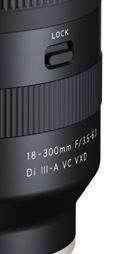
Model B061
Focal Length 18-300mm
Max. Aperture F/3.5-6.3 Blades 7 (circular diaphragm)
MOD 5.9 in (WIDE) 39 in (TELE)

Max. Mag. Ratio 1:2 (WIDE) 1:4 (TELE)


Length 4.9 in
Weight 21.9 oz.
Filter Size ø67mm
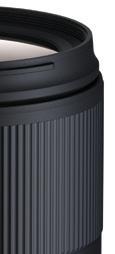
Max. Diameter ø75.5mm
Mounts
Sony E-Mount, FUJIFILM X-Mount

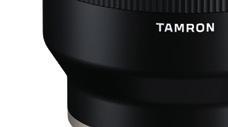

“Chrystofer Davis is a Newark, NJ native and 13-year fine art photographer, teaching artist, & filmmaker, whose work is influenced by street/portrait photography and contemporary culture. His works are currently archived in prominent institutions such as The Schomburg Center for Research in Black Culture, The Newark Public Library, The Thomas J. Watson Library at The Metropolitan Museum of Art, and The Bronx Museum. As a teaching artist, he is currently using his expertise to facilitate workshops to show the importance keeping film and developing alive; as well as documenting the many faces and architecture of Newark, NJ.”

 PHOTO: CHRYSTOFER DAVIS
ABOUT: CHRYSTOFER DAVIS
PHOTO: CHRYSTOFER DAVIS
ABOUT: CHRYSTOFER DAVIS
“I WANT TO USE MY ARTISTIC SKILLS TO CONTROL THE NARRATIVE OF WHAT NEWARK REALLY LOOKS LIKE, ESPECIALLY THE PEOPLE WHO LIVE THERE.”
INTERVIEW
Tamron Magazine 27
27mm, F/4.5, 1/120 sec., ISO 500
27mm, F/4, 1/80 sec., ISO 320

INTERVIEW 28
PHOTO: RICK GERRITY
THE FACES AND PLACES OF AMERICA


Once Rick Gerrity stopped flying, a whole new world opened up on his cross-country drives with the Tamron 35-150mm F/2-2.8 all-in-one zoom.


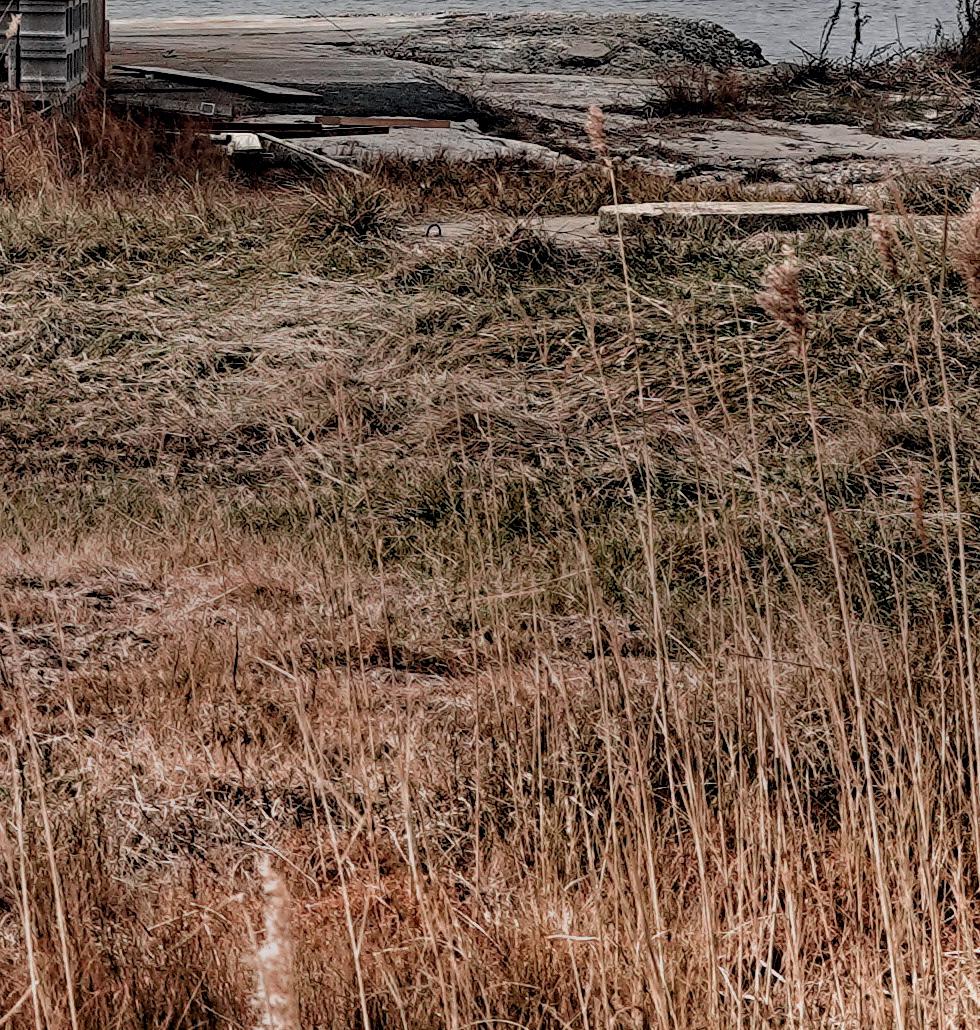

INTERVIEW
Several years ago, Rick Gerrity couldn’t book a flight to Vegas for a press conference at CES, and so he decided on the spur of the moment to drive there, from his home in New Jersey. “I left that day, on a Thursday, and made it there by Saturday,” he says. “On the way home, I thought, ‘This is great. I can take my time now and stop wherever I want to take some pictures.”
After that cross-country journey, Rick started driving to CES every year, and to most other places, and so was born his “Photographing America” project. “I just decided not to fly anywhere anymore,” he says. “I bought a map and started seeking out tiny towns across the nation. If a town has less than a thousand people in it, I’m there.” Rick has since been to every state except Alaska, though he concedes he didn’t drive to Hawaii, which he has visited many times, including for his son’s wedding. The truck he started his adventures in now has more than 500,000 miles on it.

With Rick on his most recent travels: the Tamron 35-150mm F/2-2.8 Di III VXD all-in-one zoom lens for his Sony mirrorless camera system. “This lens is absolutely perfect for me,” he says. “I can capture wide landscapes in low light thanks to the F/2 maximum aperture, take beautiful portraits of the people I meet, and then capture headshots or close-up detail images. With the 35-150, I can be sitting in a diner for hours and be able to capture scenes of the whole place, then zoom in to capture the people I’m chatting with, without ever leaving my counter stool. That lens is a godsend for this type of project.”
In finding places to photograph, Rick leans toward towns that are completely off the beaten path. “People will send me apps and recommend the world’s greatest road trip to me, and those are exactly the places I don’t want to be,” he says. “If it’s a tourist spot, that’s not for me. I’m drawn to old-school America, with carnivals, cars that are decades old, and the nearest ATM not for another 30 miles—the towns that still exist in a different time.”
That could mean stopping to take a picture of a dilapidated beachfront home that’s been owned by one family for generations, or a classic shot of Main
92mm, F/4.5, 1/250 sec., ISO 3200
37mm, F/8.0, 1/1250 sec., ISO 400

30 Tamron Magazine INTERVIEW
Street USA—even if Rick happens to capture the photo in a major American city. “This photo of the ‘Jesus Saves’ cross was taken in the Strawberry Mansion section of Philadelphia,” he says. “It’s such a cool structure, on an old church. But even though it was taken in Philly, this could be a photo found in plenty of small towns across America. That’s why I wanted to convert it to black and white, to give it a more timeless, classic feel.”
In approaching his potential human subjects, Rick places an emphasis on respectful curiosity for their lives. “You never want them to feel like you’re exploiting them,” he says. “My interactions usually just start with a ‘hello,’ and then a conversation from there. Many times I won’t even initially take my camera out of the truck with me. Often, once they hear about my project as we’re chatting, they’ll say, ‘We don’t mind if you take some photos.’”
Documenting people in their day-today environments, especially at work, is one way Rick is able to shine some light on the places he visits. “That guy you see wearing the helmet is Andres, who was born in Haiti and then moved to the Dominican Republic, where he became an excellent baseball player,” he says. “He ended up playing for the LA Dodgers for six seasons, until he blew out his shoulder, ending his pitching career. He’s a big, burly guy, and now he works in a non-ferrous foundry, making castings in sand molds. That glow you see on his face is from the hot
liquid bronze he’s getting ready to pour, which has a temperature of about 2,000 degrees.”


In Fortescue, New Jersey, Rick was able to photograph Cindy Higbee of Higbee’s Luncheonette, which she runs with her mom, Betty. “It’s all counter space, no tables, almost like a place that time had forgotten,” he says. “The town only has a few hundred people, so everyone in there knows everyone. I’d been there for about an hour and a half, eating breakfast and talking to the folks who were there, when I finally said to Cindy, ‘Come on, I have to get a photo of you.’ She seems

genuinely relaxed and in her element. I was able to blur out the background just enough to keep the focus on Cindy, but you still get a sense of place, from the coffee pots to the pictures on the wall.”
Among some of Rick’s favorite photos are ones he captured while documenting the Fletcher Street Urban Riding Club, a nonprofit group founded by Ellis Ferrell in Philadelphia that offers the city’s kids a chance to learn how to ride and take care of horses. “Ellis’ entire family is involved in the effort,” Rick says. “The woman you see with the horses here is Joy, Ellis’ daughter. She happened to
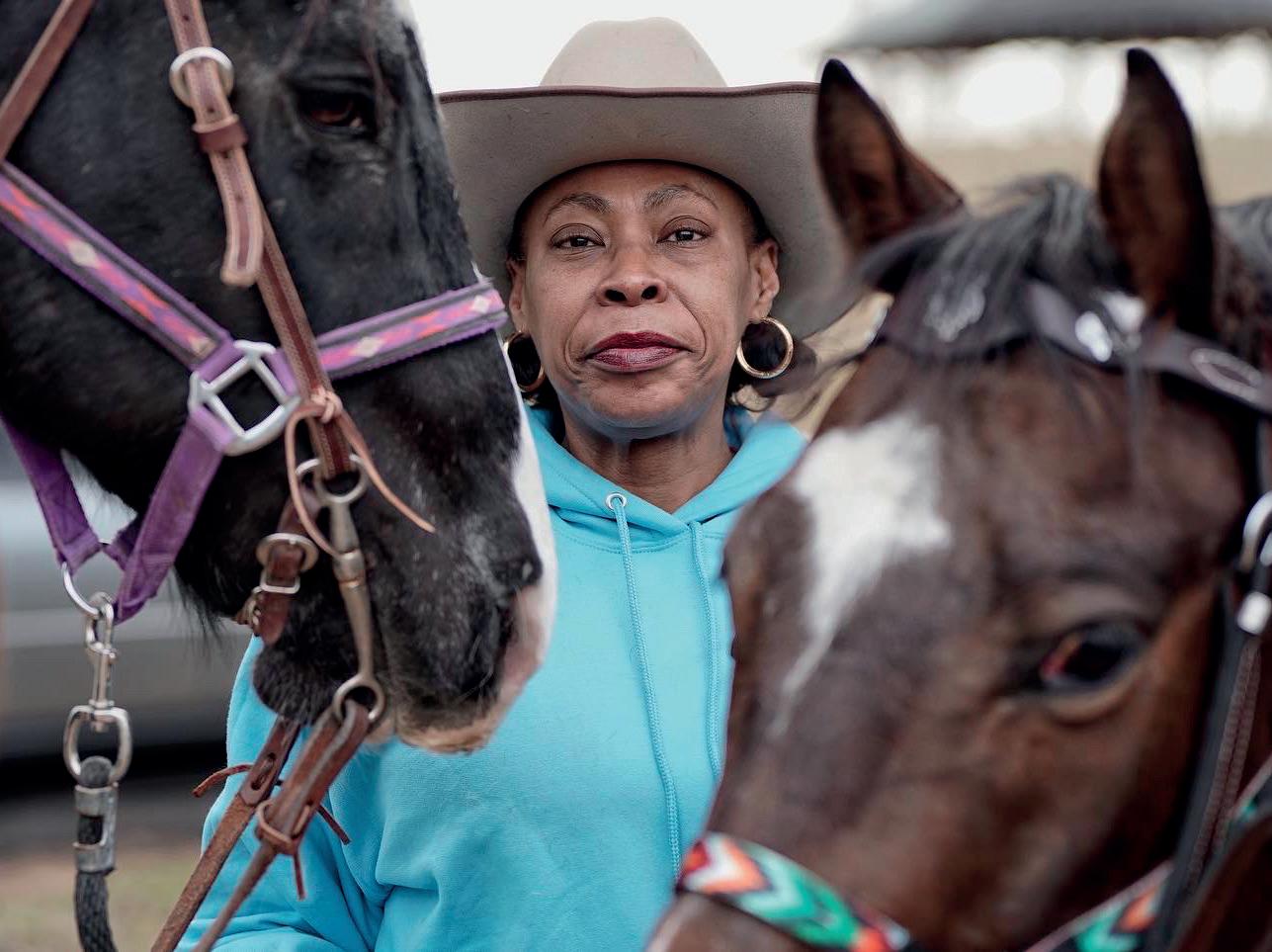
Tamron Magazine 31 INTERVIEW
“WITH THE 35-150, I CAN BE SITTING IN A DINER FOR HOURS AND BE ABLE TO CAPTURE SCENES OF THE WHOLE PLACE, THEN ZOOM IN TO CAPTURE THE PEOPLE I’M CHATTING WITH.”
PHOTO: RICK GERRITY
76mm, F/2.5, 1/125 sec., ISO 2000
78mm, F/2.5, 1/800 sec., ISO 250
turn and look at me, right between those two horses, and I was able to zoom in to 150mm and take the photo. I wasn’t that close to her, so if I didn’t have this Tamron zoom lens, I would’ve missed that opportunity.”
A fictionalized Netflix movie, Concrete Cowboy, was made about the group in 2020, and Rick was able to photograph one of the actors, Jamil Prattis. “He’s an actual rider in the club and helps out,” Rick says. “The 35-150 allowed me to blur out the background and capture a terrific portrait of him. Then,
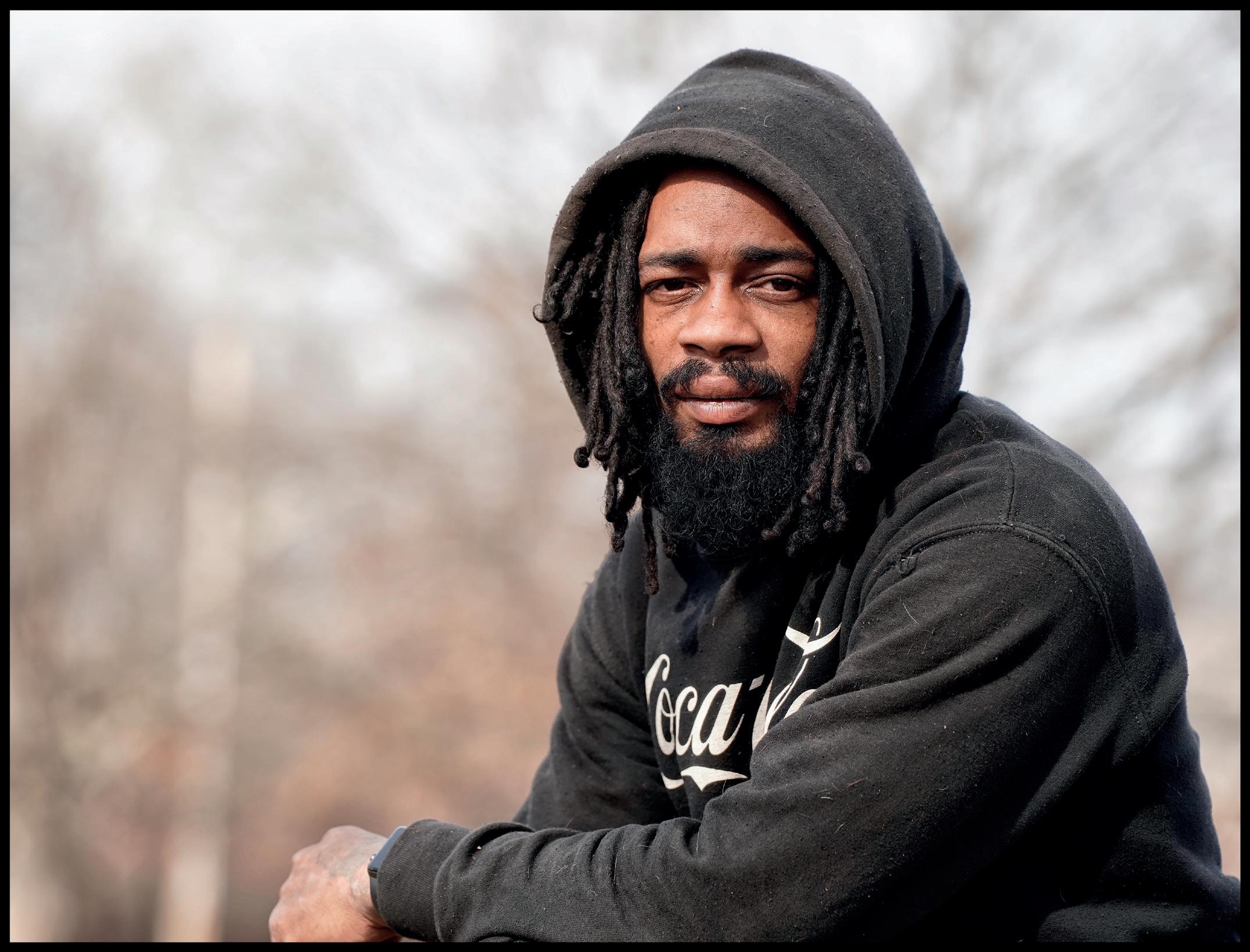
without missing a beat, I was able to zoom in to 150mm and focus on that ring on the hand of Laszlo, who showed up on horseback wearing a full-length mink coat. He was quite a character. I happened to glance down at his hand and notice the ring, and I was able to capture the shot without having to run up to him. You can really see the sharpness and clarity the lens offers in that detail shot.”
Capturing people doing what they love best is another way to ensure authenticlooking photos. “If you go to a biker bar on an ordinary day, for instance,
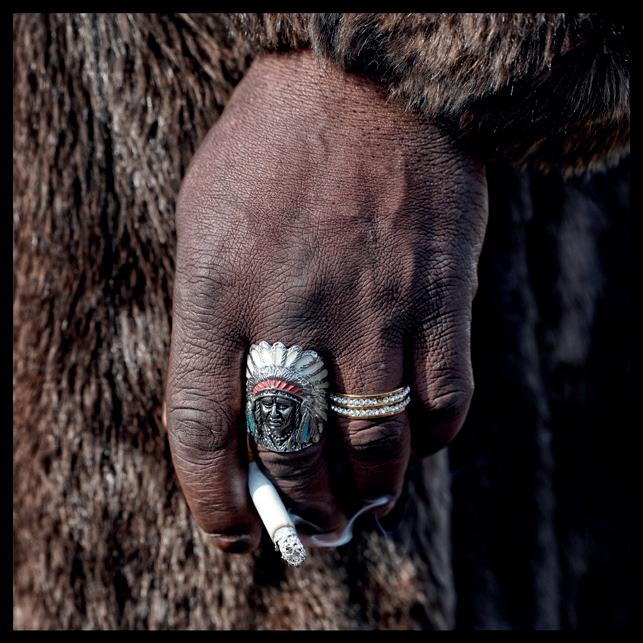
32 Tamron Magazine INTERVIEW
TIMES
TAKE MY CAMERA OUT
150mm, F/4.0, 1/640 sec., ISO 250 150mm, F/5.0, 1/500 sec., ISO 250
“MY
INTERACTIONS USUALLY JUST START WITH A ‘HELLO.' ...MANY
I WON’T EVEN INITIALLY
OF THE TRUCK WITH ME."
150mm, F/2.8, 1/320 sec., ISO 3200
you’ll encounter some genuinely gritty characters,” Rick says. “Those regulars will laugh and roll their eyes when Bike Week rolls around, because suddenly all the guys who are trying to be tough weekend bikers roll in. They can barely ride the new Harleys they just bought.”


One of those regular bikers, a woman named Nancy, allowed Rick to photograph her, but only if he cropped her face out. “She said she didn’t have the right makeup on,” he laughs. “But she had on these wild chaps and a great hat, so I knew I had to take her photo somehow. I captured her sitting on her bike, not doing anything for show, but simply being who she is—the real deal.”
Barrens, and his work.”


The photos Rick has captured in his travels are priceless. But so, too, are the friendships he’s forged along the way. “I make friends with all the people I meet, because I genuinely care about them,” he says. “I keep up long-term relationships long after I’ve left their towns, through text, phone calls, and social media. And it’s funny, because even though things seem so polarized everywhere right now, when I’m sitting down with strangers I’ve just met, from all walks of life, rarely does politics enter our talks. We just share a meal, chat, and get to know each other.”
150mm, F/2.8, 1/320 sec., ISO 800
ABOUT: RICK GERRITY


Sometimes Rick finds his subjects in unusual ways. He’d seen an episode of the late Anthony Bourdain’s Parts Unknown program in which the star had traveled to his home state of New Jersey. A historian featured on that show caught Rick’s eye. “This guy is a really amazing singer, and he plays the guitar as well,” he says. “He also creates things out of sea glass. I thought he was such an interesting-looking person, so when I got to that area, I tracked down his phone number and explained what I was doing with this project. He asked where I was, and when he figured out I was just two blocks from his house, he said, ‘I’ll put the coffee on now, come on over.’ We spent hours talking about music, the Pine
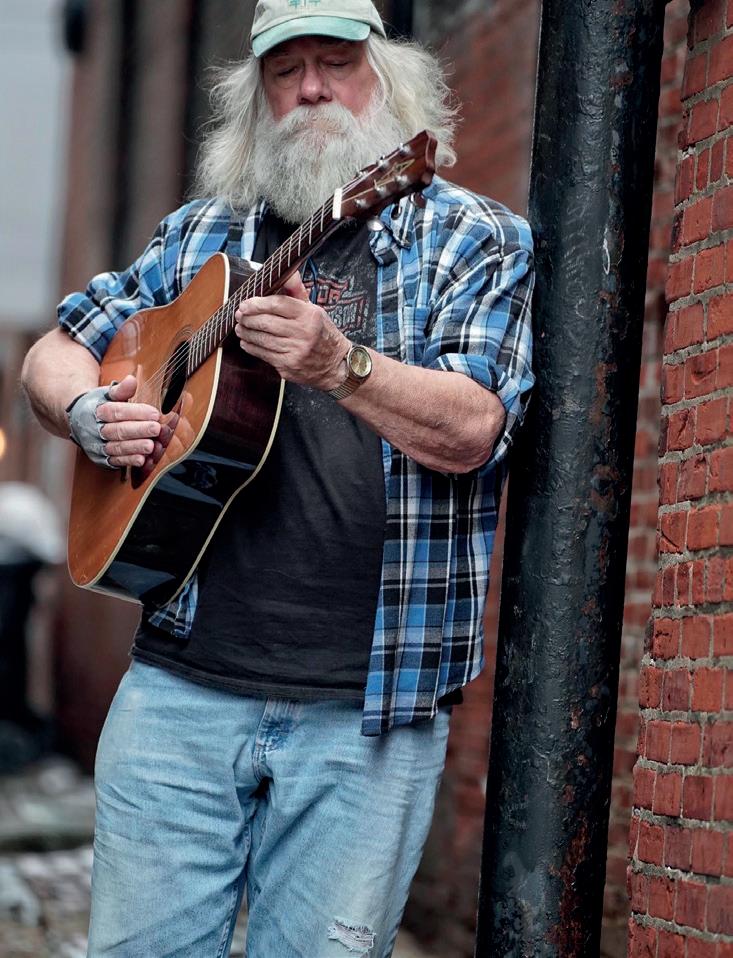
As for that final state on Rick’s checklist? “I’m going to get to Alaska eventually,” he says. “I might have to get a new car first, though. I don’t know if that truck with 500,000 miles is going to make it.”
make it.” 35-150mm




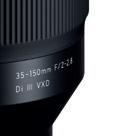






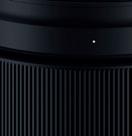




doing with this project. He asked where I




















Rick has been a published professional photographer for over 40 years based in the NYC/NJ metro area. He specializes in people, product, location assignments and documenting everyday life in the US and Canada. His images of people include Paul Newman, Sylvester Stallone, Kevin Smith and Oliver Stone to name a few. Rick's commercial images include work for Panasonic, BMW, Sony, Samsung and IBM.

Tamron Magazine 33
INTERVIEW
F/2-2.8 Di III VXD Model A058 Focal Length 35-150mm Max. Aperture F2-2.8 MOD 13 in (WIDE) 33.5 in (TELE) Max. Mag. Ratio 1:5.7 (WIDE) 1:5.9 (TELE) Length 6.2 in Weight 41.1 oz. Mounts Sony E-Mount
PHOTO: RICK GERRITY
IN DEEP WITH THE GREAT WHITES
Dustin Burkhouse documents the ‘majestic’ side of these apex predators with his Tamron 28-75mm F/2.8 G2 zoom lens.

34
Magazine PRAcTIcE
PHOTO: DUSTIN BURKHOUSE
Tamron
42mm, F/4.5, 1/1000 sec., ISO 400
41mm, F/4.5, 1/1000 sec., ISO 400
Dustin Burkhouse had been immersed in taking ocean wave pictures for several years when an image he saw in 2018 shifted the trajectory of his photography. “It was a picture of a shark below the water during an amazing sunset,” he says. “I’ve always been fascinated with sharks, and I wanted to know how someone could take a picture like that.”
Fast-forward to 2019, when Dustin traveled to Guadalupe Island, off the west coast of Mexico, and found out firsthand. “It’s the best place in the world to see great white sharks,” he says. “It’s a pretty intense trip: a five-day excursion, where you live on the boat for the entire time. It takes 20 hours alone to get to the island, which the general public isn’t allowed to go on, because it’s run by the Mexican government. On one side of the island, the waters are really rough, but on the other side, the water is extremely deep, and that’s where the sharks go to feed. There may be a couple of hundred of them there at one time.”

Dustin’s go-to lens for this type of photography is the Tamron 28-75mm F/2.8 Di III VXD G2 zoom. “I’d previously been using two prime lenses, a 28mm and 85mm, and I knew I wanted to have a zoom lens for my shark photography,” he says. “I picked up the 28-75 and was blown away by how fast the autofocus is with my Sony mirrorless camera system, and how sharp my images are, as well as how light the lens is. It’s obviously incredibly useful to be able to zoom and not have to constantly get out of the water to switch lenses.”

Tamron Magazine 35 PRAcTIcE
Up to four people at a time are submerged in each safety cage for the shark viewings. Dustin admits that the first time he went under, he panicked— not because of the sharks, but because of his breathing regulator. “The cages are right below the water’s surface, though, so I soon realized I was close to safety and was able to calm down,” he says. “By the end of the trip, I was one of the people who was underwater the longest, for hours at a time, trying to capture as many photos as I could.”
Dustin tries to depict what he calls the “majestic” side of the sharks—i.e., photos that show a more nonmenacing perspective. “I do take pictures of the sharks with their mouths open, showing their teeth, but I also like to capture photos of them where they look more serene, like they’re almost smiling,” he says. “I also love to show off the shades of their skin against the blues of the water for a beautiful, clean look.”
He looks at being underwater with the sharks, camera in hand, as a form of meditation. “I get that many people might think it’s terrifying being so close
to them, but for me, it’s very peaceful,” he says. “You’re not thinking about anything else except what’s going on around you. I’m going back to the island in September, and I can’t wait to see what pictures I capture next with my Tamron lens.”
PHOTO TIPS: SHARK IMAGES

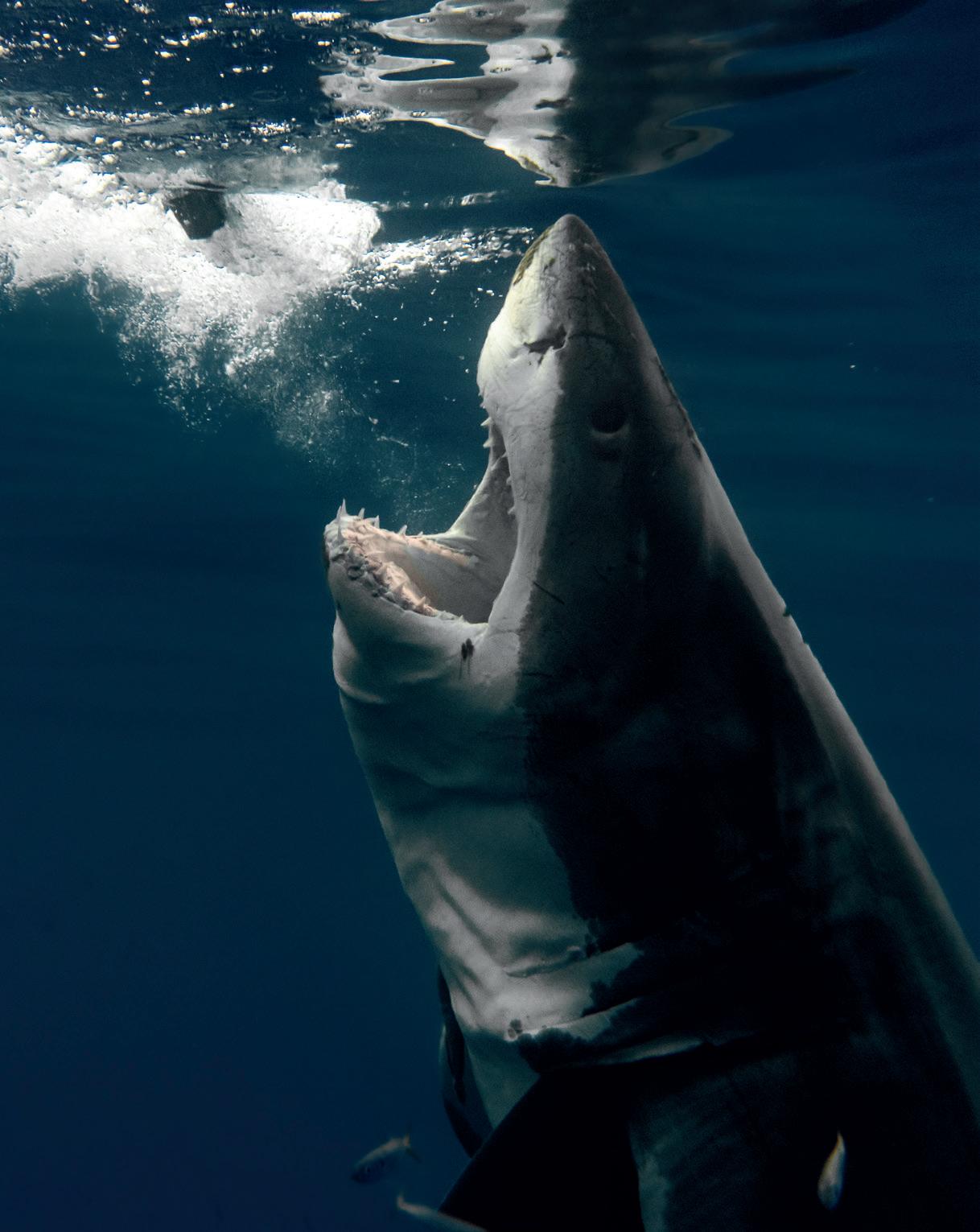
1 Make sure you have a reliable camera housing.
Other than my camera and lenses, the underwater housing is the most important part of my shark photography gear bag. The housing has to be durable, as you get shaken up in the cage a lot. The sharks themselves will sometimes ram into the cage and you’ll fall to the ground, so you need that protection.
2 Use a fast, versatile zoom lens like the 28-75.
The currents in these types of waters can be wild. Even when you’re standing still, the cages may still be rocking back and forth. I use autofocus with my Tamron 28-75mm and am always able to capture the photos I want. If you don’t have a fastfocusing lens, you’re going to miss a lot
47mm, F/4.0, 1/1250 sec., ISO 800
of opportunities. Plus, having this highquality zoom lens has provided me with clear, sharp detail images I wouldn’t have been able to get otherwise.
3 Lock your settings in.
The maximum F/2.8 aperture on the 28-75 is perfect. I used to drop it down as low as possible to achieve more of a portrait style, though now I usually keep it between F/4 and F/9. I always set my shutter speed as high as I can—usually above 1200—as the sharks are constantly on the move, and my ISO below 400. The water in Mexico is so clear and the lighting so fantastic that those settings work best.
4 Base your positioning on the lighting. Some photographers bring strobes underwater, but I only shoot in natural lighting. It’s a lot of work to wrangle all that gear underwater, and I’d rather just be with the sharks. I also personally like the look of all-natural light better. When I first started out, I was more concentrated on simply getting as many pictures as I could that were in focus. Now that I’ve got more of a handle on that, I look for as many opportunities as I can to work in the interplay of light and shadow that happens as a result of the way the sunlight hits and enters the water.
39mm, F/4.0, 1/1000 sec., ISO 400
PRAcTIcE
36 Tamron Magazine
43mm, F/5.0, 1/1000 sec., ISO 400 40mm, F/4.0, 1/1000 sec., ISO 400
Obviously you have a limited space to work in when you’re in the cage, but I’ll watch the sun throughout the day and how it’s filtering down through the water and hitting the sharks, and that’s how I’ll determine where to stand. For instance, on my trip, the right side of the cage was perfect during the morning sessions. Toward the end of the day, the left side became the better side to shoot from. In terms of whether you’re photographing the sharks head-on or from above or below, that’s often dependent on where the sharks are swimming, though you can do a certain amount of crouching down and moving around a bit to try to achieve different angles.
5 Fill the frame with the shark’s face.
With this Tamron lens able to zoom into 75mm, I can capture very detailed images of the shark’s face, especially the eyes. That’s why so many of my photos are straighton shots, with the shark directly in front of me as it’s swimming toward the cage. It’s awesome to center it in the frame and have it looking you right in the eye. The viewer feels like they’re there with you, confronting this creature of the deep.

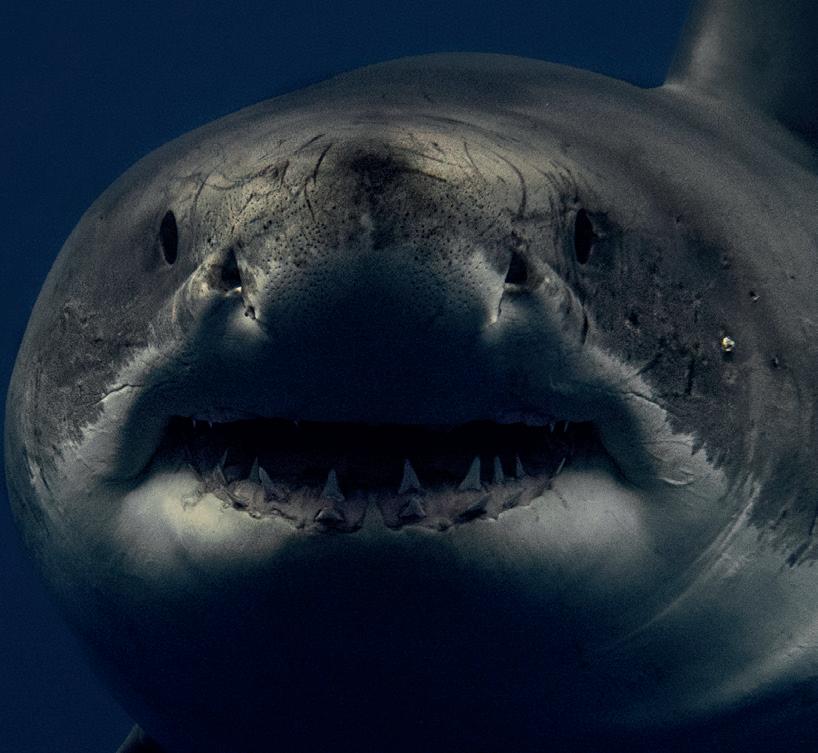
6 Incorporate other elements into the picture.
This year especially, I’ve been trying to capture photos that show I’m seeing the shark from inside the cage—basically a frame-within-a-frame kind of image. I’ve also been experimenting with photographing the shark so that I also get other people in the shot. That can be difficult, because
there’s not a lot of room in the cage, and the autofocus tends to pick up on the humans more than something swimming around in the background, but I’ve been getting better at that.
I was able to capture one very cool photo of a mackerel swimming toward me, where I got the mackerel in focus, but also the giant shark swimming behind him. That photo went viral. I’ll also try to capture sharks swimming underneath the boat when I can, because that always makes for a neat picture.
7 Use the water itself as a visual element. I don’t usually plan on capturing shark reflections or bubbles in the water, because you can’t typically plan those kind of things, but I’m always very excited when it happens. In those cases, the image is typically lighter, whiter blues at the top and then becomes darker and more mysterious as your eye travels further down the photo. That ombré look has become a signature style of mine.
28-75mm F/2.8 Di III VXD G2

Model A063


Focal Length 28-75mm Max. Aperture F/2.8 MOD 7.1 in (WIDE) 15 in (TELE) Max. Mag. Ratio 1:2.7 (WIDE) 1:4.1 (TELE) Length 4.6 in Weight 19 oz. Mounts Sony E-Mount
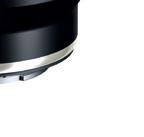

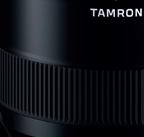

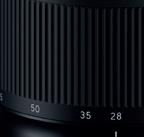


42mm, F/4.5, 1/1000 sec., ISO 400
ABOUT: DUSTIN BURKHOUSE









Hi, my name is Dustin Burkhouse and I am an ocean and landscape photographer from Northern California. My main focus is underwater photography and videography. In the last few years, I've been passionate about filming marine animals such as great white sharks, whales, and anything the ocean has to offer. I tend to spend more time capturing what's below the surface but when I'm on dry land I love taking landscape and travel photos.

PRAcTIcE
PHOTO: DUSTIN BURKHOUSE
“WITH THIS TAMRON LENS BEING ABLE TO ZOOM INTO 75MM, I CAN CAPTURE VERY DETAILED IMAGES OF THE SHARK’S FACE, ESPECIALLY THE EYES.”
Tamron Magazine 37
WILDLIFE MADE ACCESSIBLE

You don’t have to look far in the national parks to find photo ops, as Julia Cook proves with her Tamron SP 150-600mm VC USD G2 ultra-telephoto zoom lens.

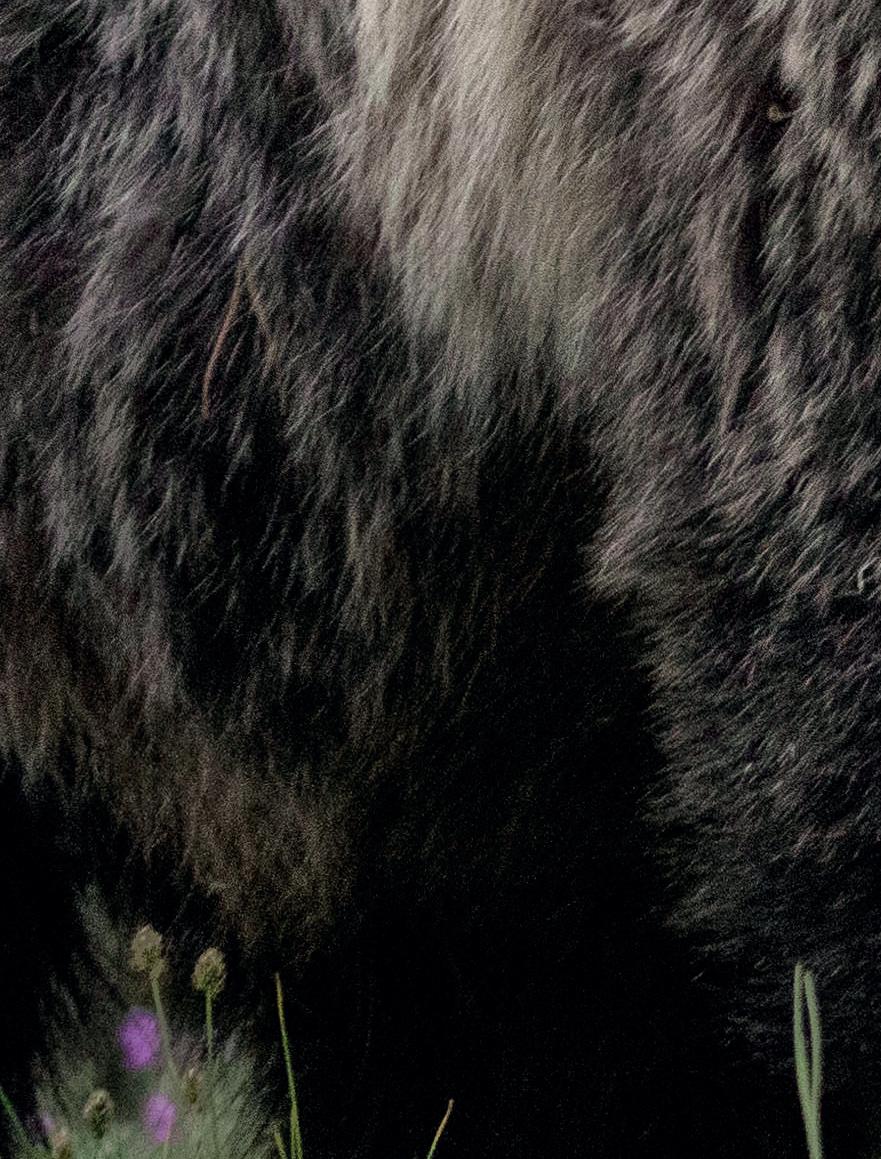

 PHOTO: JULIA COOK
PHOTO: JULIA COOK
PRAcTIcE 38
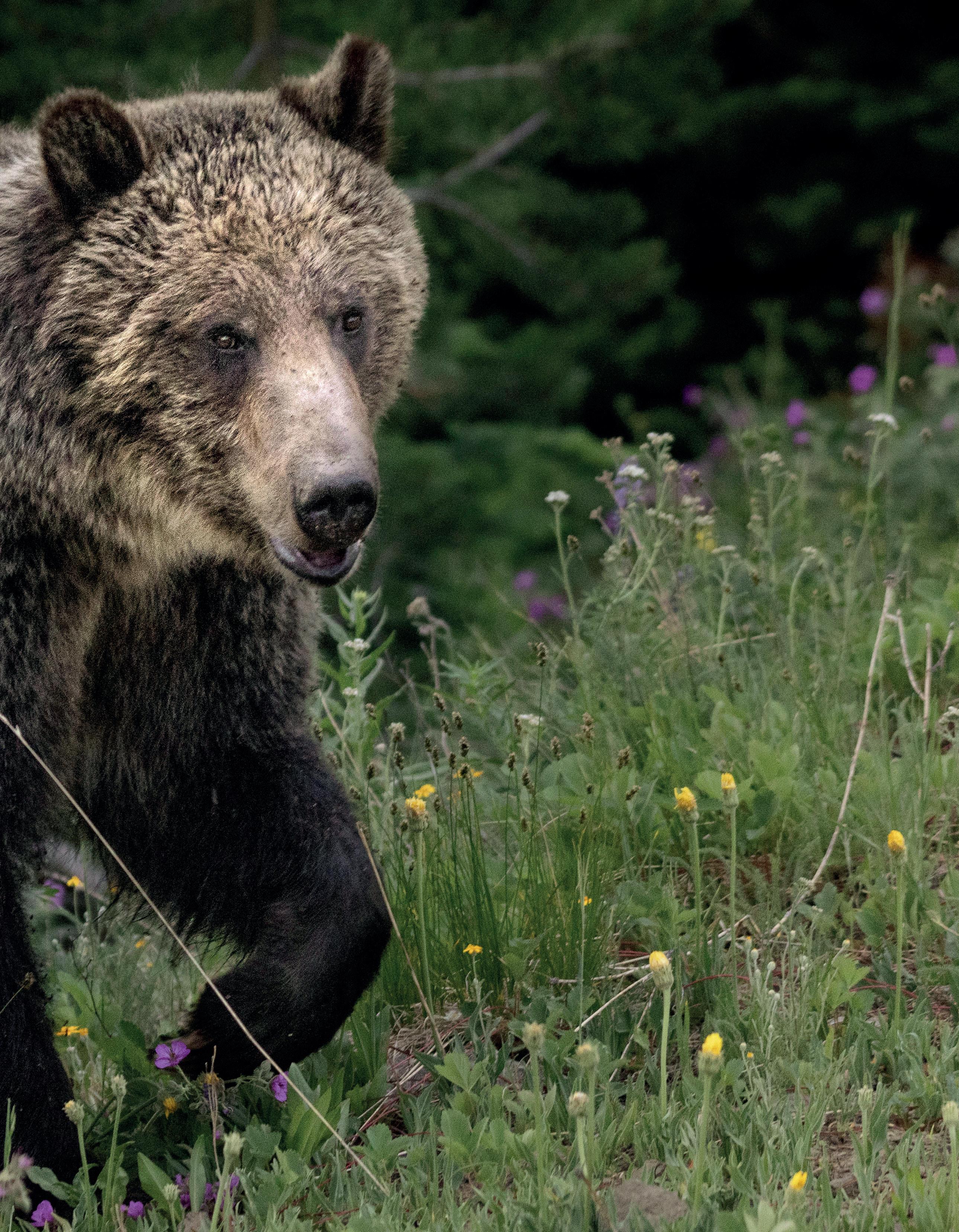
PRAcTIcE 191mm, F/5.6, 1/400 sec, ISO 1600
W
yoming native Julia Cook visited Yellowstone National Park more times than she could count as a kid, and those visits haven’t died down, even now that she’s a college student majoring in environment and natural resources at the University of Wyoming. These days, however, Julia always has a camera in hand during her trips to both Yellowstone and other national parks, creating wildlife images she hopes will inspire others to enjoy the great outdoors and respect the environment.
On her camera is the Tamron SP 150600mm VC USD G2 ultra-telephoto zoom lens, a photographic tool that offers her the range, portability, and image quality she desires, as well as the ability to remain unintrusive and safe. “This is the only lens I’ll take into Yellowstone,” she says. “My favorite thing about it is the variety of focal lengths at my disposal, as well as how lightweight it is, which is important when I’m spending all day in the park. I also couldn’t do without the Vibration Compensation (VC) feature, since I shoot handheld—I hate lugging a tripod around with me when I’m in the parks, and the VC minimizes camera shake, ensuring my images stay sharp. With the 150-600, I’m able to adapt as quickly as the animals move. If one suddenly darts in a different direction, I can easily move along with it without feeling restricted or that I’m missing photos.”
PHOTO TIPS: WILDLIFE IMAGES

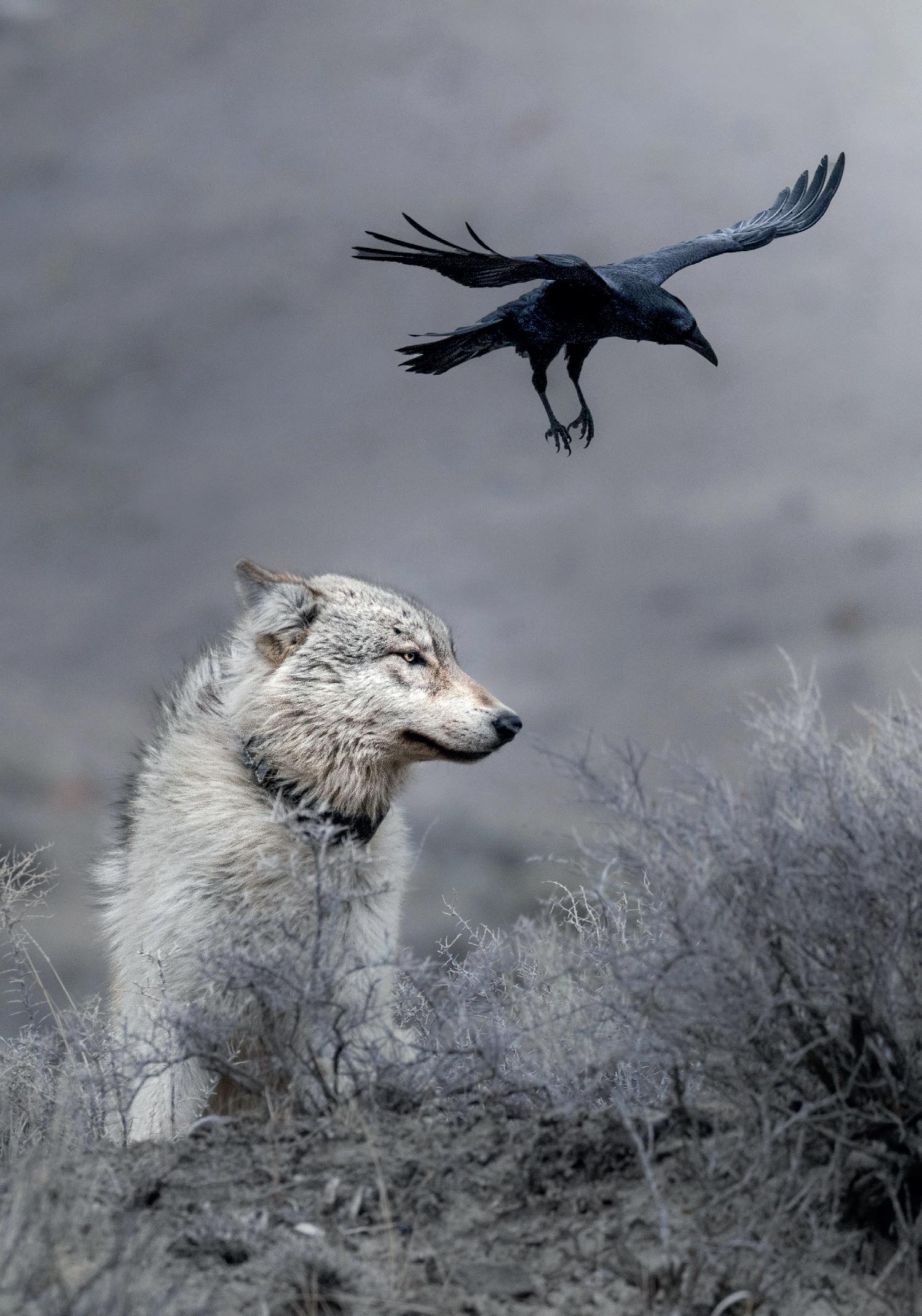
1 Know the park’s safety regulations. In the national parks, there are rules regarding how far you have to stay away from the animals, and you should get to know them well so you keep yourself and the animals safe. For bears and wolves in Yellowstone, that distance should be at least 100 yards, or 300 feet. I always try to think of it as, if I’m in one end of an end zone on a football field, the bear should be in the other end zone. It’s also important that you respect and listen to the park rangers.
2 Research the animals you plan on photographing. I always think of wildlife photography as an intersection between art and science— because there is a science to knowing when the animals are going to be active. If you go out in the middle of the day,
PRAcTIcE
552mm, F/6.3, 1/400 sec, ISO 800 483mm, F/9, 1/1600 sec, ISO 800
you’re probably not going to have the best chance of photographing a bear. It’s helpful to know a little about their environment and what their behavior might be. The more time you spend observing certain animals, the easier it becomes to predict what they’re going to do, which allows you to plan your photos accordingly.
3 Realize the best wildlife opportunities aren’t necessarily in the remotest parts.
I don’t think that most people realize how accessible bear-viewing is in many of the national parks. In the photo of the bear strolling through the wildflowers in Yellowstone, it gives the appearance of being in some far-flung corner of the park, where nobody else is around. In reality, on the right-hand side of the frame, the road is maybe about 4 feet from the bear. People think you have to do a major hike through the backcountry to see bears, and that’s not the case.
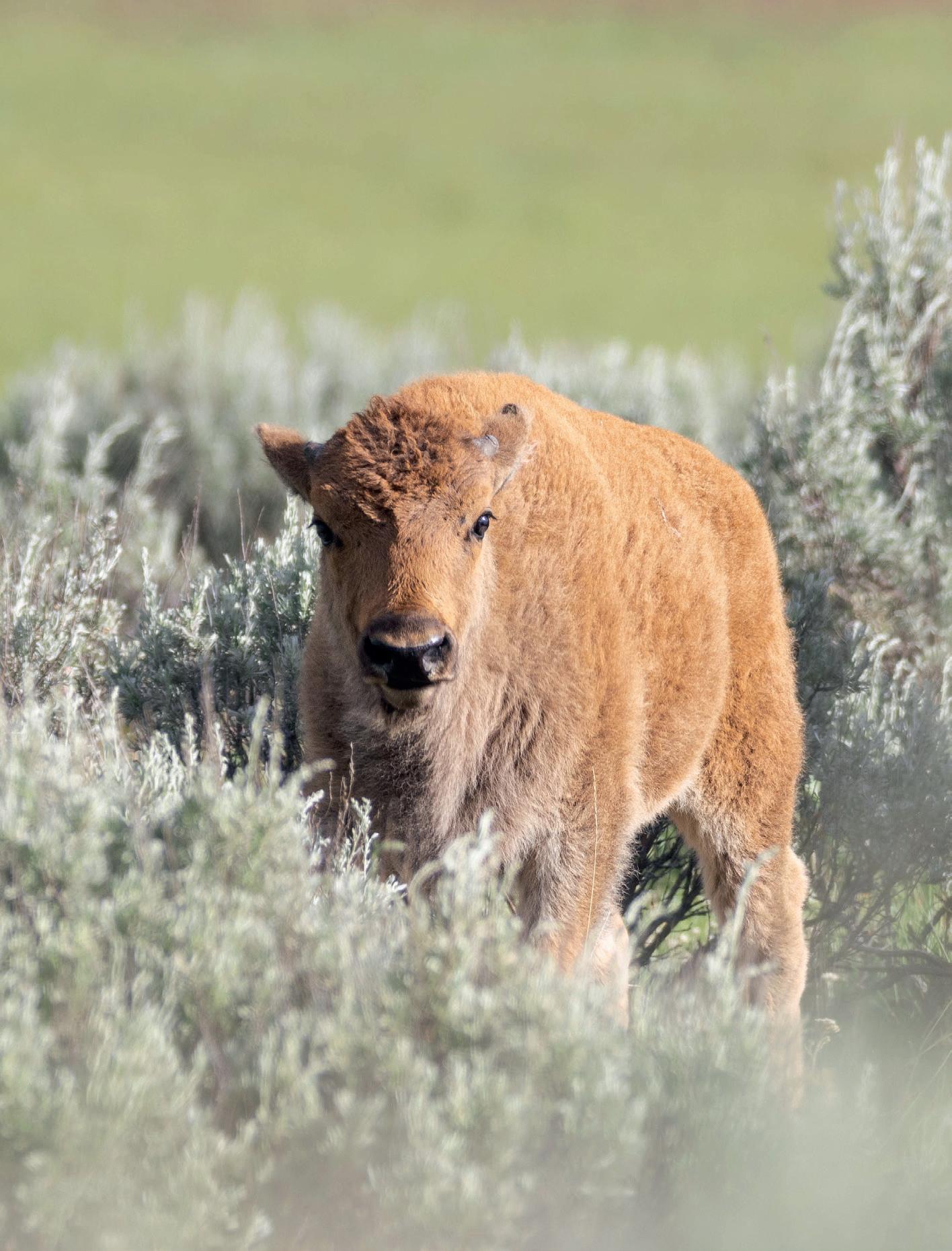
4 Shoot from lower angles if possible, preferably at eye level.
I would say that when I’m photographing wildlife, I’m kneeling or lying on the ground about 80% of the time. With the coyote photo you see here, I was on the ground in Yellowstone, fully on my stomach, trying to achieve a lower angle. Or, if there’s a distracting element obstructing my field of view, I’ll position myself directly behind it so it blurs out in the foreground. That’s what I did with the photo of the bison calf. If I’d been taking the picture from a higher angle, that sagebrush it was standing in wouldn’t have blurred out, and the photo would’ve been too distracting with all of the detail in the brush.
5 Blur out the background to keep the focus on the animal.
Most of the other photographers who were taking pictures of this moose in Grand Teton National Park were photographing him head-on, so he was directly looking at them. But what you can’t see here, due to the way I cropped my photo, is that there was a tree directly behind him that would’ve made for a super-busy picture. That’s why instead, I took a profile shot, where there was a lot of distance between the moose and the yellow aspens in the background. That
distance helps blur out the background. In this case, it also provided an appealing, colorful canvas behind the moose.
6 Be unobtrusive and quick on your feet with birds of prey.
Raptors can be hard to photograph because they’re often skittish. I had seen the eagle shown here in Yellowstone land on a perch, so I pulled over to photograph it. The second my camera went up, however, the eagle took off.
This is the only picture I managed to get, with its wings half-folded out and ready to go. With owls, however, you might have a better chance, especially if they’re often around humans and acclimated to them. Gray owls also tend to perch at eye level, which is definitely nice for photos. I tried to stay far enough away from this one, which is where the 150-600 came in especially handy. It didn’t seem bothered by me at all.
Tamron Magazine 41 PRAcTIcE
PHOTOS: JULIA COOK 309mm,
1/640 sec, ISO 200
F/5.6,
“WHEN I'M PHOTOGRAPHING WILDLIFE, I'M KNEELING OR LYING ON THE GROUND ABOUT 80% OF THE TIME.”
7 Keep an eye out for interspecies interactions.

What’s interesting about wolves and ravens is that they have a symbiotic relationship, where they both benefit from a sort of cooperation with each other. In fact, ravens are often called “wolf birds.” If wolves see ravens circling in the sky, they’ll follow the ravens, because they figure there’s a fresh kill nearby. Meanwhile, ravens similarly follow wolves so that they can scavenge from the wolves’ kills.
On this particular day in Yellowstone, the wolves had killed a deer early in the morning, and after they’d picked off most of the good meat, they receded up onto this ridge line. That’s when the ravens came swooping in for their turn. That’s what makes this photo so funny—you would think the wolf and the raven would be concentrated on each other, but they don’t even care. They’re both looking in the same direction, focused on the meal below.
420mm, F/6.3, 1/640 sec, ISO 400
8 Don’t discount a photo op because it doesn’t seem photogenic enough.
When I first spotted these black bear cubs and their mom in Yellowstone, they were
really high up on a ridge in the middle of the day. The lighting was terrible, the brush was tall, and the cubs were so small that you couldn’t really see them. I think many people would’ve kept driving
500mm, F/6.3, 1/400 sec, ISO 1000
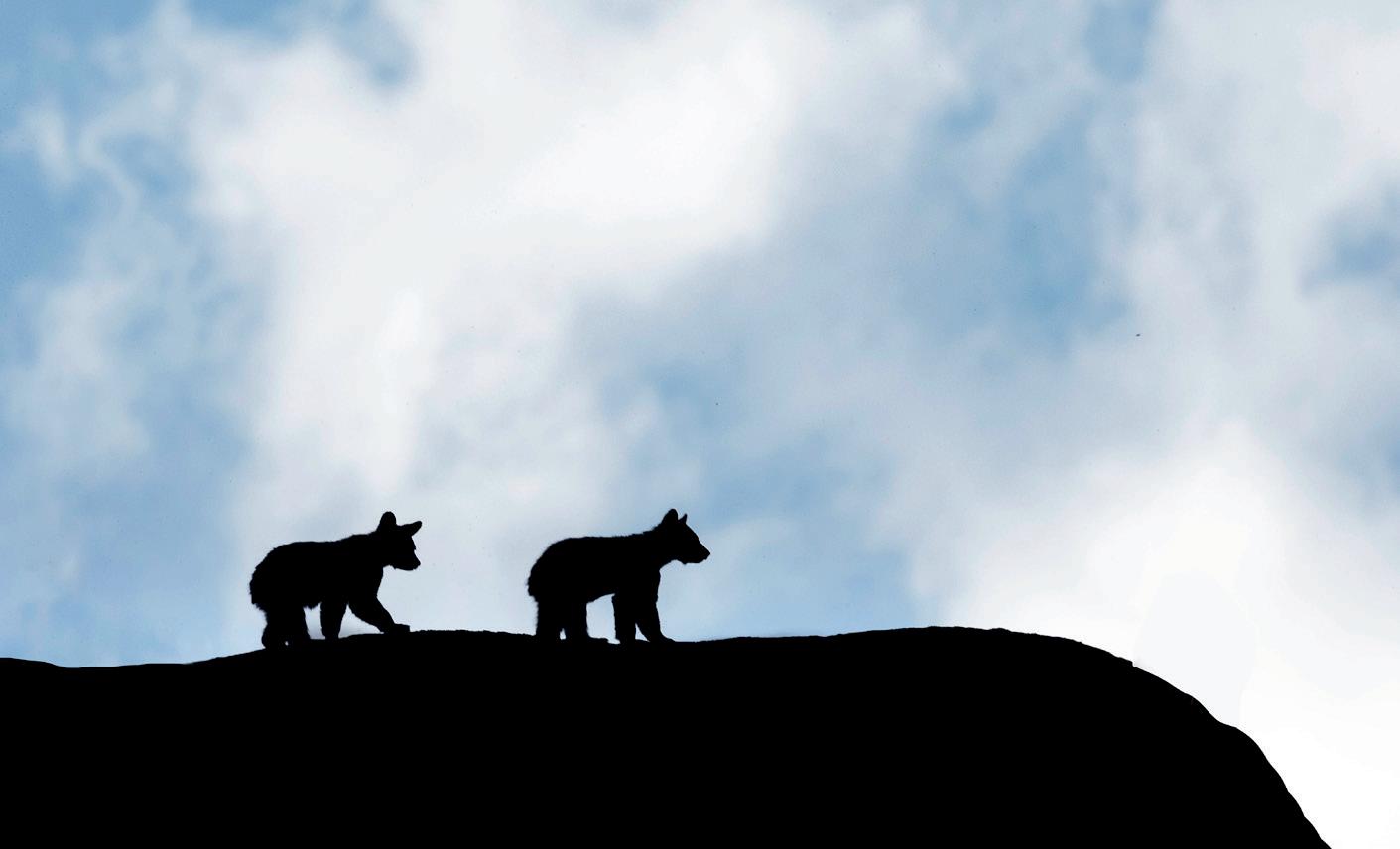
PRAcTIcE
because it didn’t seem like a great chance to capture a photo. But I pulled over and waited just a little longer, and the cubs happened to walk up onto this boulder, where I was able to capture their silhouettes. Just because a scene doesn’t initially look promising doesn’t mean it won’t improve.
9 Always be ready for unexpected moments.










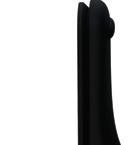
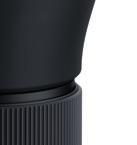
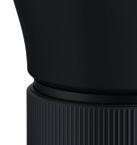




For my photo of an elk, it was my first time in Colorado’s Rocky Mountain National Park, which is known for its elk rut, or mating season. I was out of my element in this place I hadn’t been to before, and I had no idea what was going to transpire. Before the sun rose, nothing was happening; all the elk were bedded down. Then the sun came up and the light hit the meadow, and this massive-like bull elk just came out of nowhere and started bugling. The whole valley came to life, and all the elk started bugling back and forth to each other. I like the resulting image, with the lit-up meadow and the trees still shaded in the back. SP 150-600mm F5-6.3
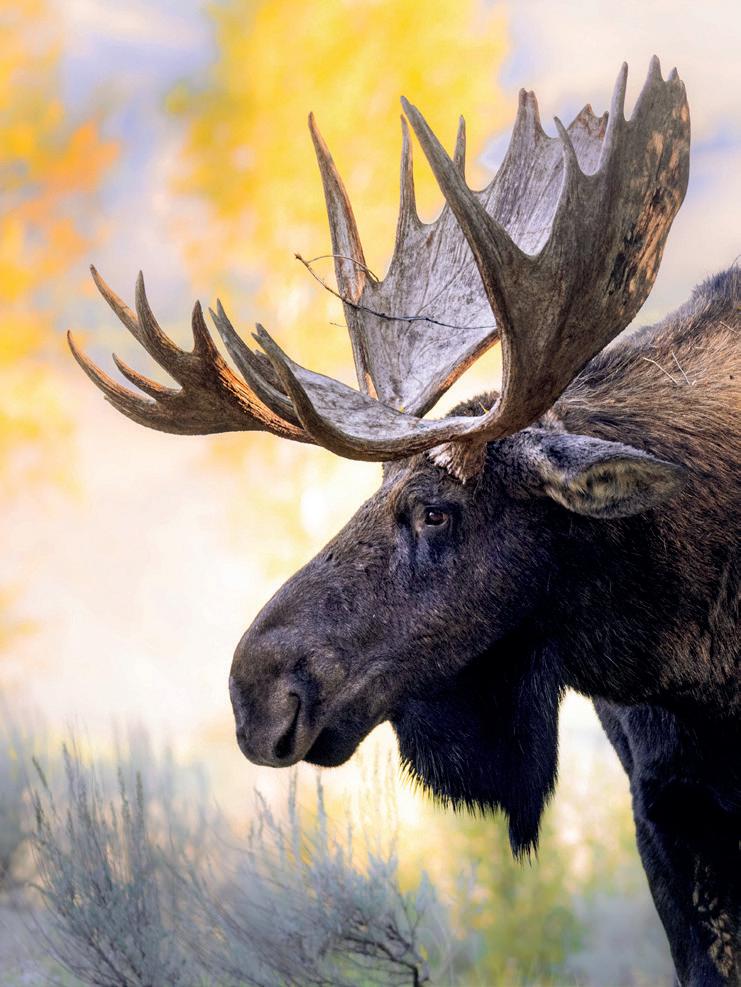

Julia Cook is a wildlife photographer based in the Greater Yellowstone Ecosystem of Wyoming. Growing up in Wyoming surrounded by the outdoors, Julia developed a love for nature at an early age, which eventually led her to begin photographing wildlife; her wild subjects are her biggest inspiration. Julia spends most of her free time in Yellowstone photographing various species of wildlife, though grizzly bears are a favorite. Currently a senior at the University of Wyoming studying Environment and Natural Resources, Julia’s overall goal in photography is to capture impactful images of native wildlife that highlights their wilderness while inspiring others to enjoy nature in a meaningful way. When not photographing wildlife, Julia enjoys writing, traveling, drawing, and spending time with her lab Beach.




Tamron Magazine 43 PRAcTIcE
Di Vc
Model A022 Focal Length 150-600mm Max. Aperture F/5-6.3 MOD 86.6 in Max. Mag. Ratio 1:3.9 Length 10.2 in Weight 70.9 oz Mounts Canon and Nikon DSLR or mirrorless with mfg adapter
ABOUT: JULIA COOK
500mm, F/6.3, 1/640 sec, ISO 1000 226mm, F/5.6, 1/320 sec, ISO 800 PHOTOS: JULIA COOK “THE MORE TIME YOU SPEND OBSERVING CERTAIN ANIMALS, THE EASIER IT BECOMES TO PREDICT WHAT THEY'RE GOING TO DO, WHICH ALLOWS YOU TO PLAN YOUR PHOTOS ACCORDINGLY.”
213mm, F/9, 1/400 sec, ISO 640
MY PROJECT FRAMING THE SCENE

Every landscape Tamron Student Ambassador Chris Timothy encounters in his travels has the potential to become a photo, thanks to his reliable trio of Tamron lenses.

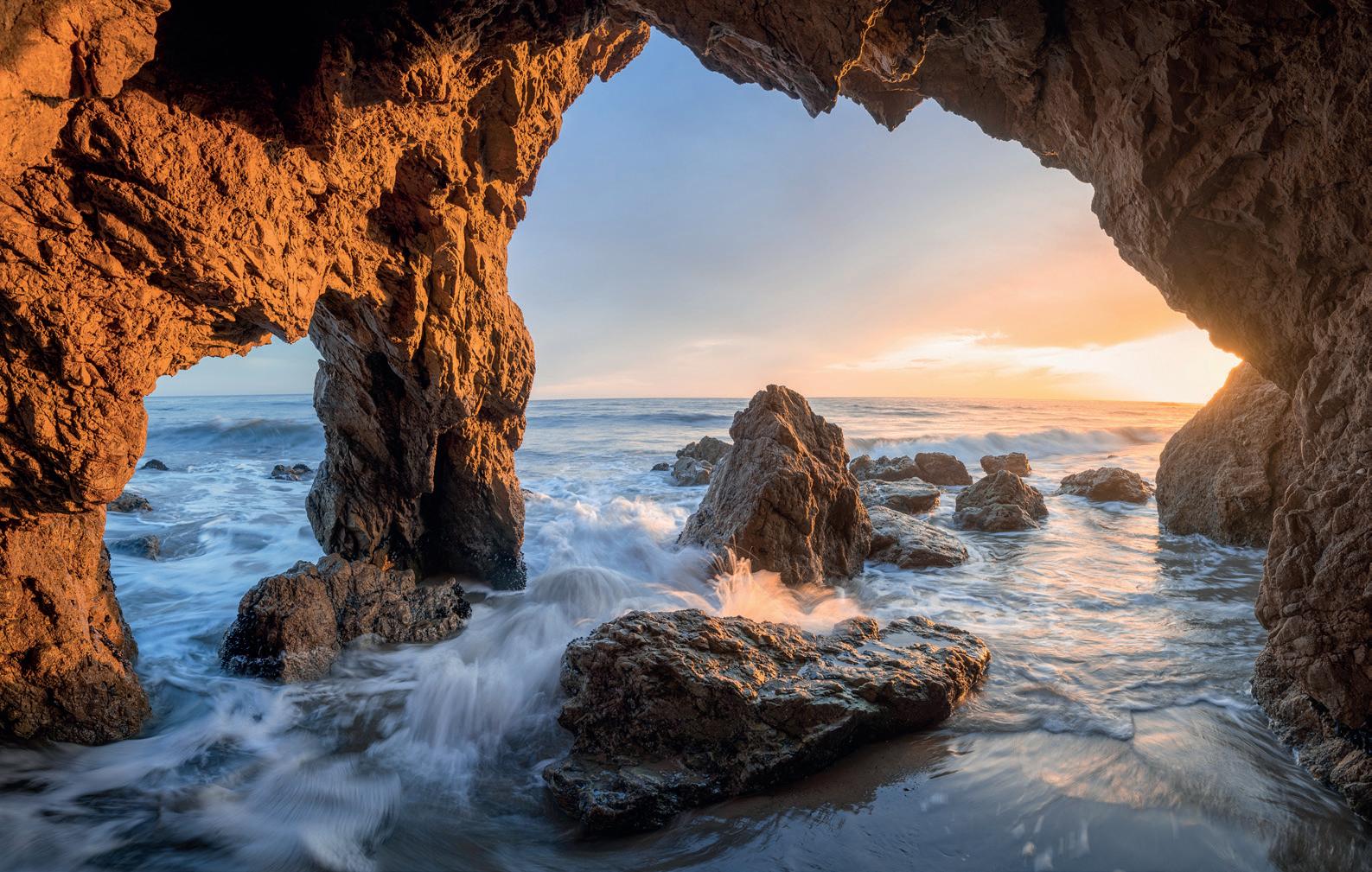
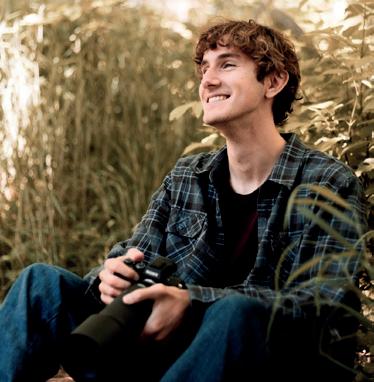
Life has been busy for me lately—I’m entering my sophomore year at James Madison University, and I was recently named a Tamron Student Ambassador—but I always carve out the time to indulge my passion for travel landscape photography. When I was growing up, my family took a lot of trips, which is how I became exposed to the beauty of the great outdoors. We also regularly visited art galleries and museums, where I’d be especially drawn to exhibits by top travel landscape photographers. Those two things inspired me to start visualizing all of the scenes I experienced as if they’d one day be framed.
In 2018, my photography really started taking off. In my travel landscape images, I now focus on making sure there’s always a clear subject within the photo, finding parallelism and symmetry, and showing a sense of scale when possible. That’s why I travel so often with family or friends—I always have someone with me whom I can ask to run ahead and serve as my subject against the landscape.
My goal is to capture the essence of what each particular place offers, to establish the vibe of that destination in just one frame. That can be a tall task, but I’ve found that by heading to popular locations in the blue hour or even in the middle of the night, I’m able to capture a unique perspective that others may be missing. I love shooting sunrises and sunsets, and during the golden hour, as much as any photographer. But in midday or
44 Tamron Magazine 17-28mm
F/8, 1/40
17-28mm
(17mm),
sec., ISO 100
(17mm), F/9, 1/3 sec., ISO 100
the evening, when the stars are your backdrop, you can take advantage of photo opportunities that will allow your work to stand out.

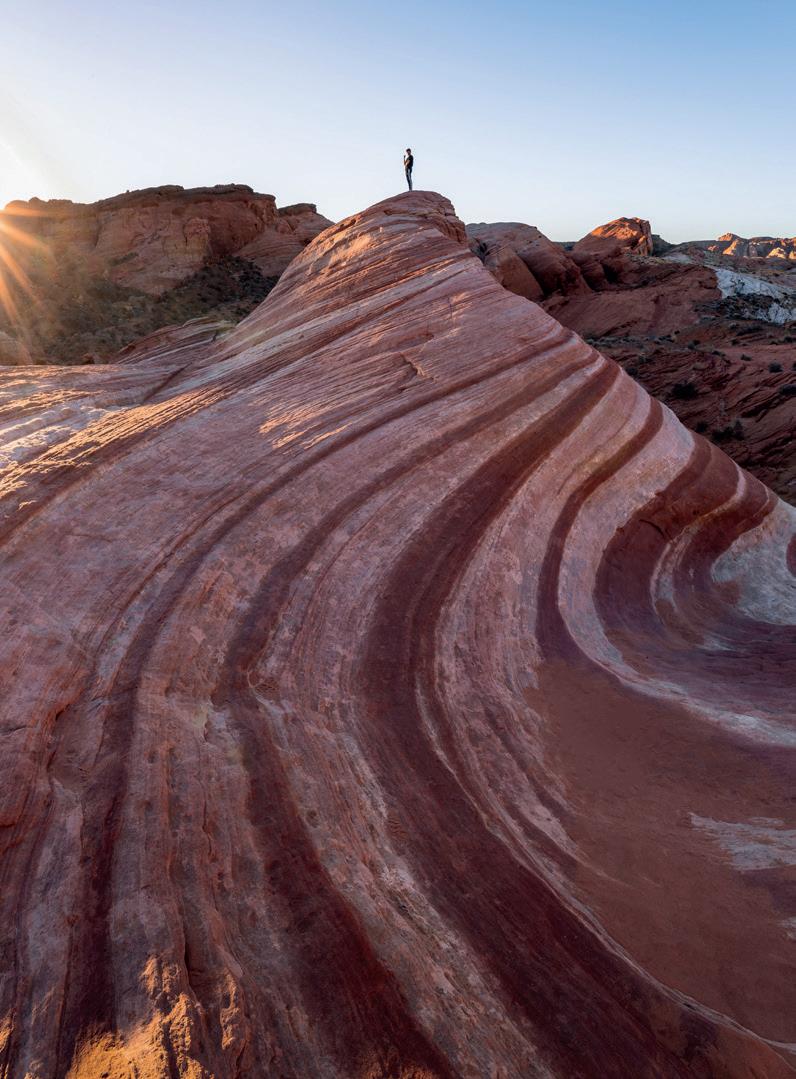
I currently have three Tamron lenses that help me achieve my photographic style: the 17-28mm F/2.8 ultra-wide-angle zoom, the 28-75mm F/2.8 G2, and the 70-300mm Di III RXD telephoto zoom, all for my Sony mirrorless camera. Those lenses are magical, because they cover every situation I could possibly encounter in my photo adventures. For example, if I head to the Grand Canyon, I can use the ultra-wide 17-28 to achieve a panoramic view of the whole scene, or I can zoom in to one element of the scene using the 28-75. Meanwhile, the 70-300 would give me the extra reach I need if I wanted to zoom in even further to show off the layers and details in the rocks. Plus, the sharpness, color rendition, and dynamic range on all three lenses is fantastic.

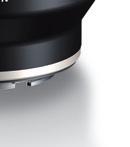
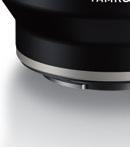

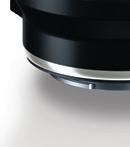



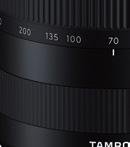

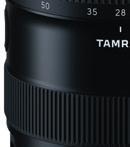
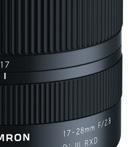




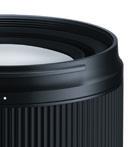

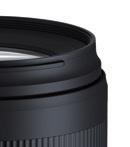

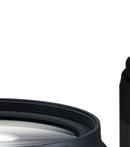


It’s those vibrant colors, textures, and leading lines of a scene that make me want to take a picture. One of my favorite things to do is to discover a brand-new way of photographing a location, finding a composition that allows the natural elements of the scene to lead the viewer’s eye through it. Sometimes, though, I simply get lucky, like when I was in a park just south of Miami. The lighting was phenomenal, allowing me to capture the palm trees in silhouette, but just as I was getting ready to take the photo, a guy rode through the scene on his bicycle. Those are the kind of images you can’t plan for, but with the right lenses, you won’t miss them.

TIMOTHY










Tamron Magazine 45 MY PROJEcT
Location: Northern Virginia Occupation: Student Photographic Specialty: Landscapes/Cityscapes Passions: Light chasing, art, nature preservation Favorite Lenses: 17-28 F/2.8, 28-75 F/2.8, 70-180 F/2.8, 150-500 F/5-6.7 Instagram: @christphertimo 70-300mm (111mm), F/11, 1/2500 sec., ISO 100 28-75mm (28mm), F/10, 1/13 sec., ISO 100 17-28mm (17mm), F/11, 1/30 sec., ISO 100 28-75mm (75mm), F/9, 1 sec., ISO 100 28-75mm F/2.8 Di III VXD G2 [model A063] 70-300mm F/4.5-6.3 Di III RXD [model A047] 17-28mm F/2.8 Di III RXD [model A046]
PROFILE: CHRIS
17-28mm (17mm), F/2.8, 1/100 sec., ISO
cONTAcT MAGAZINE
FEEDBACK

tamroneditor@tamron.com #tamronusamagazine

CUSTOMER SERVICE
If you have any questions about our products or services, get in contact with us: Telephone: 1-800-827-8880 / prompt 1 Email: custserv@tamron.com Mon-Fri 8:45am – 5:00pm EST
REPAIRS
Tamron products are manufactured with the greatest care and precision. However, should there be any damage to your lens, Tamron Customer Service will be happy to assist you. All Tamron lenses purchased through an authorized Tamron USA retailer are supported with our 6-Year Warranty and 3-Business Day Repair Turnaround at no extra charge. You can find contact addresses and more detailed information on the warranty and the procedure for sending in the product and having it repaired on our website: www.tamron-usa.com/support
NOTIcE
An Adirondack Sunrise
After scouting this location several times to predict the sun position rising over the mountains, my dream Adirondack sunrise shot became a reality in summer of 2020. The composition is a single image that captured the beauty and detail of the entire scene, all while staying focused on the Adirondack chairs in the foreground. Captured with my Tamron 17-28mm F2.8 (Model A046): 17mm; F20; 1/100 sec, ISO 100 ©Joe Serio Instragram: @photos_by_jserio

46 Tamron Magazine
LEGAL
Publisher: Tamron USA, Inc., 10 Austin Blvd, Commack, NY 11725 Editor: Stacie Errera Writer: Jennifer Gidman Staff: Lisa Keller, Sabrina Retas Contributors: Ken Hubbard, André Costantini Production and layout: Stephen Reisig / Real Imagination Printed by: Spectragraphic, New England Reprinting, reproduction in online services and on the internet, duplication onto storage media such as thumbdrive, CD-ROM, DVD-ROM etc. are only permitted with the advance written permission of the editorial staff. All information, prices, dimensions and colors are subject to correction Copyright © 2022, Tamron USA, Inc.
PARTING SHOT:
100

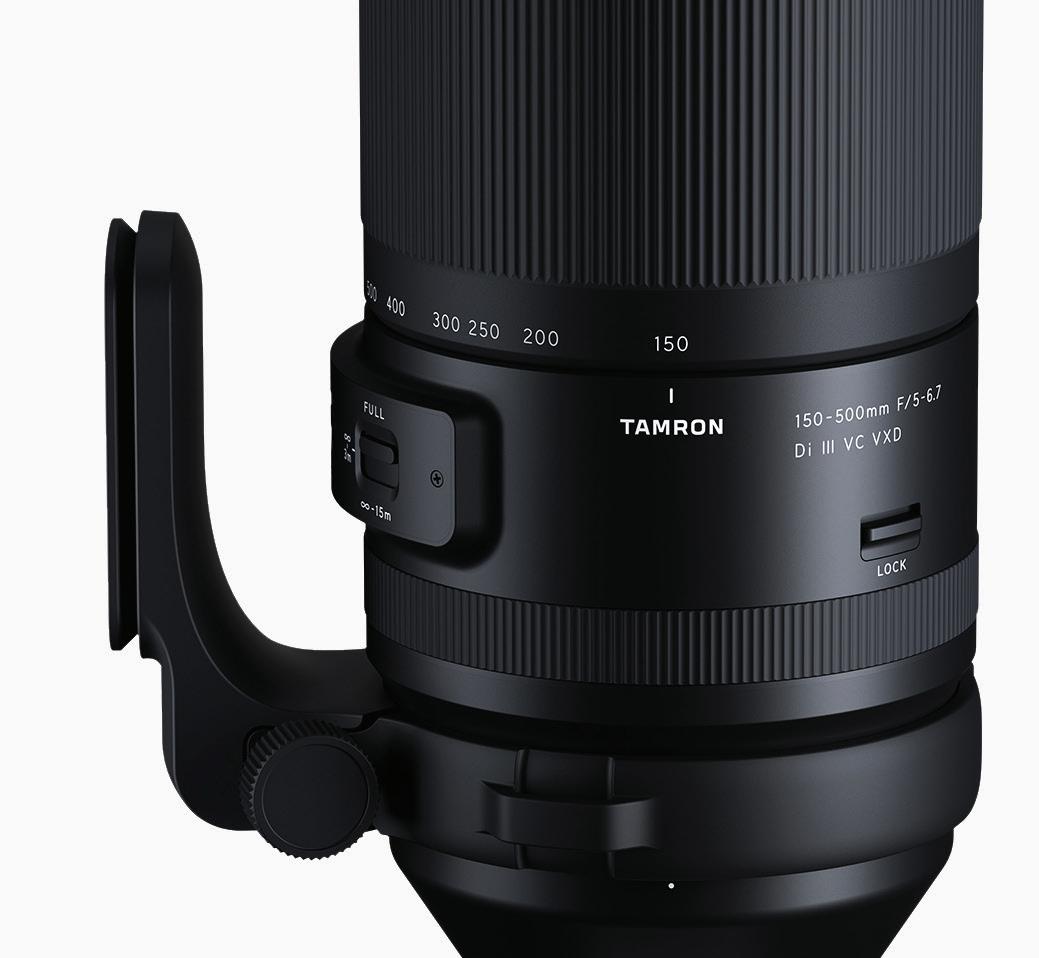


www.tamron-usa.com © Shannon Wild The compact and lightweight ultra-telephoto zoom with VC and fast AF ULTRA-TELEPHOTO ZOOM LENS for Sony Full-Frame Mirrorless Cameras [ Model A057 ] STABLE VC150-500mm F/5-6.7 Di III VC VXD ONLY AVAILABLE AT YOUR AUTHORIZED TAMRON USA RETAILER

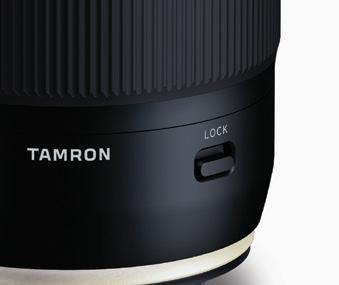
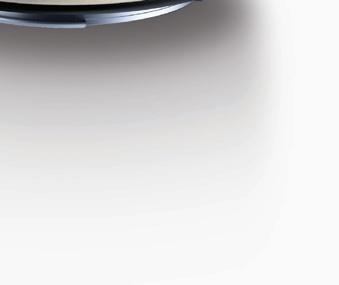



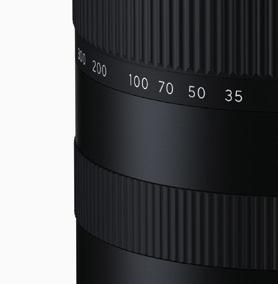






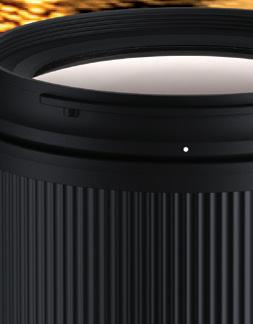






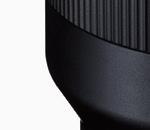
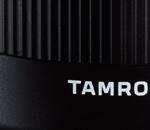


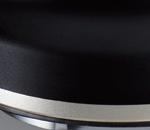













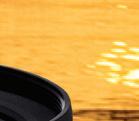


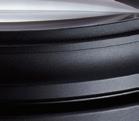






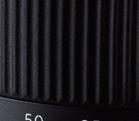





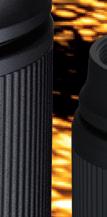
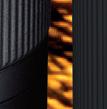

ONLY AVAILABLE AT YOUR AUTHORIZED TAMRON USA RETAILER www.tamron-usa.com Choose the perfect Travel Zoom for your next photo excursion APS-C MIRRORLESS FULLFRAME MIRRORLESS APS-C DSLR ALL-IN-ONE ZOOM LENS For Sony E-Mount [ model A071] 28-200mm F/2.8-5.6 Di III RXD ALL-IN-ONE ZOOM LENS For Sony E-Mount and FUJIFILM X-Mount [ model B061] 18-300mm F/3.5-6.3 Di III-A VC VXD ALL-IN-ONE ZOOM LENS For Canon and Nikon DSLR mount [ model B028] 18-400mm F/3.5-6.3 Di II VC HLD © Ken Hubbard







































































































 PHOTO: BREE ROSE
PHOTO: BREE ROSE

































































































































































 PHOTO: CHRYSTOFER DAVIS
PHOTO: CHRYSTOFER DAVIS





















 PHOTO: CHRYSTOFER DAVIS
ABOUT: CHRYSTOFER DAVIS
PHOTO: CHRYSTOFER DAVIS
ABOUT: CHRYSTOFER DAVIS














































































 PHOTO: JULIA COOK
PHOTO: JULIA COOK





































































































































